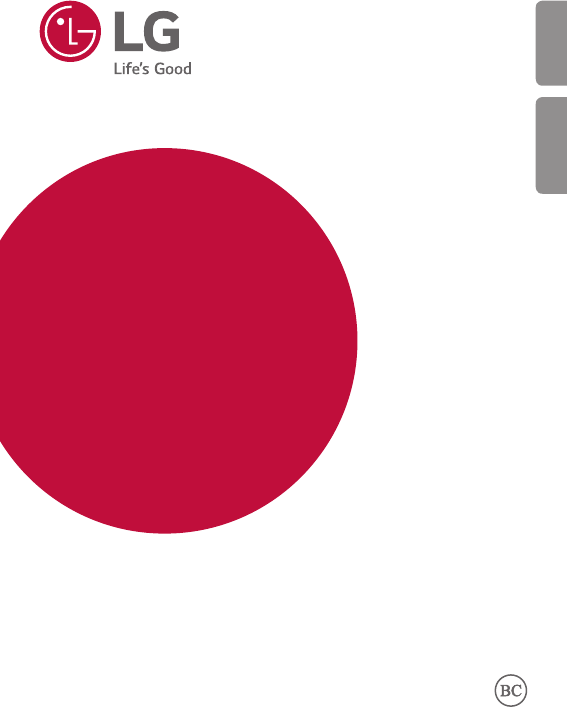LG Electronics USA M703 Multi-band GSM/EDGE/UMTS/LTE Phone with Bluetooth, WLAN and RFID User Manual 1
LG Electronics MobileComm USA, Inc. Multi-band GSM/EDGE/UMTS/LTE Phone with Bluetooth, WLAN and RFID Users Manual 1
Contents
- 1. Users Manual 1
- 2. Users Manual 2
Users Manual 1
1
About this user guide
Thank you for choosing this LG product. Please carefully read this user
guide before using the device for the first time to ensure safe and proper
use.
• Always use genuine LG accessories. The supplied items are designed
only for this device and may not be compatible with other devices.
• This device is not suitable for people who have a visual impairment due
to the touchscreen keyboard.
• Descriptions are based on the device default settings.
• Default apps on the device are subject to updates, and support for
these apps may be withdrawn without prior notice. If you have any
questions about an app provided with the device, please contact an
LG Service Centre. For user-installed apps, please contact the relevant
service provider.
• Modifying the device’s operating system or installing software from
unofficial sources may damage the device and lead to data corruption
or data loss. Such actions will violate your LG licence agreement and
void your warranty.
• Some content and illustrations may differ from your device, depending
on the area, service provider, software version, or OS version, and are
subject to change without prior notice.
• Software, audio, wallpaper, images, and other media supplied with
your device are licenced for limited use. If you extract and use these
materials for commercial or other purposes, you may be infringing
copyright laws. As a user, you are fully responsible for the illegal use of
media.
• Additional charges may incur for data services, such as messaging,
uploading, downloading, auto-syncing and location services. To void
additional charges, select a data plan suitable to your needs. Contact
your service provider to obtain additional details.
• This guide is written in the local languages for each country. Depending
on the language used, content may slightly differ.
ENGLISH
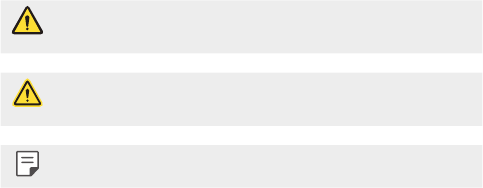
2About this user guide
Instructional notices
WARNING: Situations that could cause injury to the user and third
parties.
CAUTION: Situations that may cause minor injury or damage to the
device.
NOTE: Notices or additional information.

3
Table of contents
01
Custom-designed
Features
6 Camera features
9 Gallery features
12 Making collage wallpapers
13 Face recognition
16 Multi-tasking feature
18 quick share
02
Basic Functions
20 Product components and
accessories
21 Parts overview
23 Turning the power on or off
24 Installing the SIM card
25 Inserting the memory card
26 Removing the memory card
27 Battery
29 Touch screen
32 Home screen
41 Screen lock
44 Memory card encryption
45 Taking screenshots
45 Entering text
51 Do not disturb
03
Useful Apps
53 Installing and uninstalling apps
54 App trash
55 Phone
60 Messaging
61 Camera
73 Gallery
79 Contacts
81 QuickMemo+
83 Clock
84 Calendar
85 Tasks
86 Music
87 Calculator
87 E-mail
89 Audio Recorder

4Table of contents
89 NextRadio
90 File Manager
90 LG Mobile Switch
91 Downloads
91 Smart cleaning
92 LG SmartWorld
92 Facebook
92 Instagram
93 Chrome
93 Google apps
04
Settings
96 Settings
96 Networks
106 Sound & notification
107 Display
108 General
05
Appendix
118 LG Bridge
119 Phone software update
121 Anti-Theft Guide
122 Open Source Software Notice
Information
122 Regulatory information(FCC/IC
ID number, etc.)
122 Trademarks
123 More information
124 FAQ
06
For Your Safety
07
Safety Guidelines

Custom-designed
Features
01
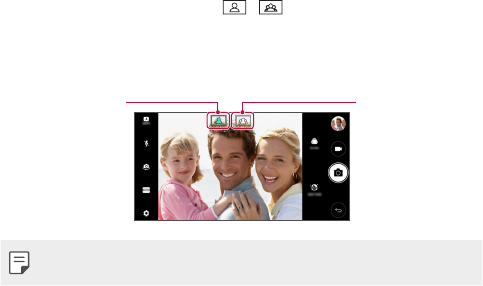
Custom-designed Features 6
Camera features
Wide-angle camera
You can take photos or record videos with a wider range than your actual
field of vision by using the wide-angle on the front camera.
Launch the Camera app, then tap / to switch between the
standard and wide-angle.
Front camera
Standard angle icon Wide-angle icon
• See
Starting the camera
for details.
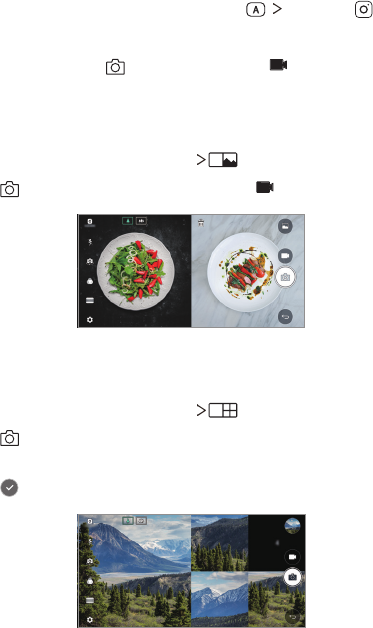
Custom-designed Features 7
Square camera mode
You can take multiple photos or videos in the form of a collage by using
the front and rear cameras. Photos and videos can be saved with different
layouts.
1 Launch the Camera app, then tap AUTO ( ) SQUARE ( ).
2 Tap MODE and select the desired camera mode.
3 To take a photo, tap . To record a video, tap .
Snap shot
You can take a photo or record a video and preview it right away.
1 In the SQUARE mode, tap MODE .
2 Tap to take photo. To record a video, tap .
Grid shot
You can take up to 4 photos organized in a square.
1 In the SQUARE mode, tap MODE .
2 Tap to take photos simultaneously or sequentially depending on
the displayed layout order.
3 Tap to save.
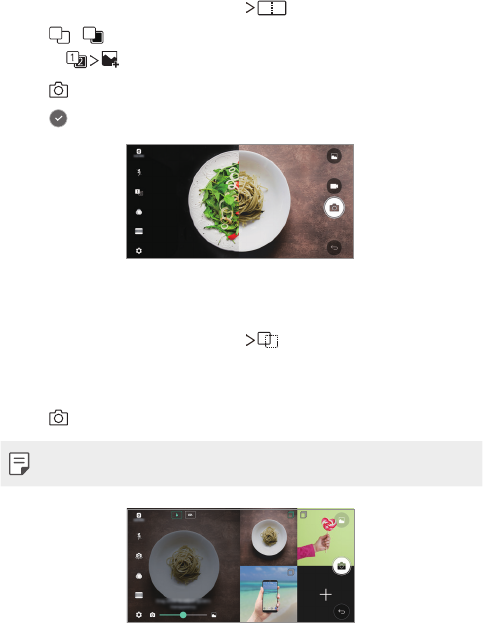
Custom-designed Features 8
Match shot
You can take 2 photos at the same time or separately.
1 In the SQUARE mode, tap MODE .
2 Tap
1
1
/
2
1
to take a photo at the same time or separately.
• Tap to use a photo from Gallery as the first shot.
3 Tap to take photos.
4 Tap to save (if necessary).
Guide shot
You can take photos by following another photo’s guide.
1 In the SQUARE mode, tap MODE .
2 Select from the guides on the right to choose the one you want to
follow.
3 Tap to take a photo.
• Use the slide bar to control the background transparency.
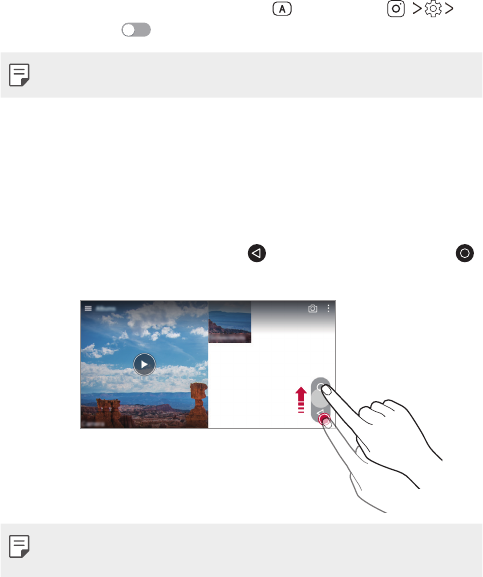
Custom-designed Features 9
Steady recording
You can use the Steady recording feature to minimize motion blur while
recording a video.
Launch the Camera app, then tap AUTO ( ) or SQUARE ( )
Steady recording .
• See
Starting the camera
for details.
Gallery features
Floating button
To quickly move to the Home screen while viewing the Gallery in
landscape orientation, touch and hold , move your finger upward to ,
then release it.
• You can move the floating button’s position by dragging it horizontally
along the bottom part of the screen.
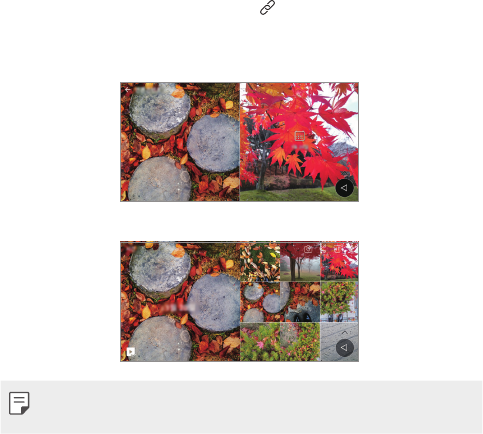
Custom-designed Features 10
Related content
You can edit and customize related content in the Gallery.
1 While viewing a picture preview, tap .
2 When the icon related with the date you took the photo appears,
touch the screen.
• You can view the photos related with the date you chose.
• Related content can be related to up to four combinations of ‘Memories,
Date, Place, Camera mode’.
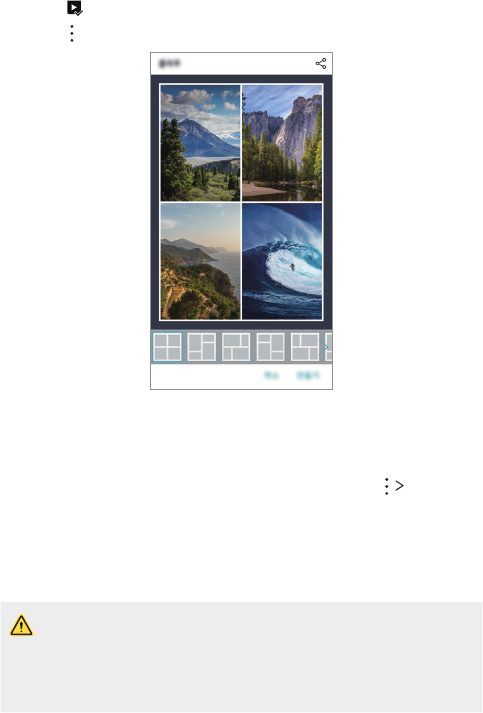
Custom-designed Features 11
• Tap to save the related content as a video.
• Tap to access additional options.
Making a GIF
You can easily make a GIF file using previously recorded video.
At the desired starting point while watching the video, tap Create
GIF.
• The GIF file is generated for the time selected from the current time.
• For videos less than 5 seconds, GIF images are automatically generated
for the remaining time.
• The GIF making feature is provided for the user’s creative activity. If you
infringe other’s copyright or defamation laws by using the GIF making
feature, you may be liable for civil and criminal liability. Be sure to not
duplicate or transfer work of others without permission. LG Electronics
cannot accept any liability for the user’s action.
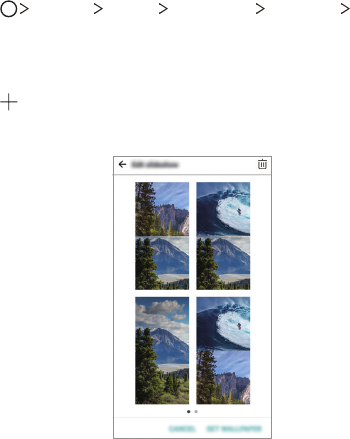
Custom-designed Features 12
Making collage wallpapers
You can make your own collage image to display it as a lock screen.
1 Tap Settings Display Lock screen Wallpaper Collage
Wallpapers.
You can select multiple collage images as a wallpaper that changes
each time you turn on or off the screen.
2 Tap and select the images you want to display as a collage.
3 Edit the slideshow as desired and tap SET WALLPAPER.

Custom-designed Features 13
Face recognition
Face recognition overview
You can release the screen lock by using the saved facial data.
• This feature may be more vulnerable to security than the other screen
locks such as Pattern, PIN, and Password.
• When a similar face or your photo image is used, the screen lock can be
released.
• The recognised facial data is securely stored in your device.
• When the face recognition is selected for screen lock, you must enter
the Pattern, PIN, or Password that has been used for face registration
without directly using the face recognition after the power is turned on.
Accordingly, be careful not to forget the specified value.
• If the device cannot detect your face, or you forgot the value specified
for registration, visit the nearest LG Customer Service Centre with your
device and ID card.
Precautions for face recognition
Face recognition accuracy may decrease in the following cases. To increase
its accuracy, check the following before using the device.
• Whether your face is covered with a hat, eyeglasses, or mask, or your
face is significantly different due to heavy makeup or beard.
• Whether there are fingerprints or foreign substances on the front of
the camera lens, or your device cannot detect your face due to a too
bright or dark light.
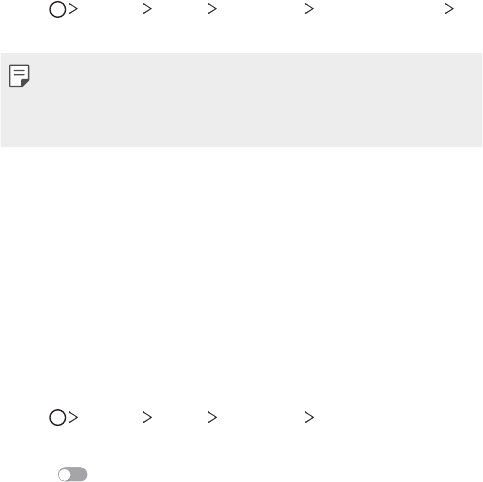
Custom-designed Features 14
Registering facial data
Before use of the face recognition feature, register your facial data on
your device.
1 Tap Settings Display Lock screen Select screen lock
Allow face recognition.
• To use this feature, the screen lock must have been set with a Pattern,
PIN, or Password.
• When the screen lock is not set, register the data by following the
onscreen instructions. See
Setting a screen lock settings
for details.
2 Raise your device in the front of your eyes.
3 Register your face by following on-screen instructions.
• Register your face in a room that is not too bright or dark.
• Position your entire face inside the guideline on the screen, and then
adjust it by slowly moving up, down, left, or right.
4 When the face registration is done, tap OK.
Unlocking the screen with your face
You can release the screen lock with your face instead of Pattern, PIN, or
Password.
1 Tap Settings Display Lock screen Select screen lock.
2 Unlock the screen according to the specified method.
3 Drag to activate the face recognition feature.

Custom-designed Features 15
Improving the face recognition
You can add facial data in various conditions to improve face recognition.
1 Tap Settings Display Lock screen Face Recognition.
2 Unlock the screen according to the specified method.
3 Select Improve face recognition.
4 Register your face by following on-screen instructions.
5 When the face registration is done, tap OK.
Deleting facial data
You can delete the registered facial data and register it again if the face
recognition does not work properly.
1 Tap Settings Display Lock screen Face Recognition.
2 Unlock the screen according to the specified method.
3 Select Delete face to delete the facial data.
Unlocking the screen with your face when the screen
is turned off
With the screen turned off, raise your device and look at the front of the
screen. The device can detect your face and the screen is unlocked.
To deactivate this feature, follow the instruction below.
1 Tap Settings Display Lock screen Face Recognition.
2 Unlock the screen according to the specified method.
3 Drag Allow when screen is off to deactivate the feature.
• Face recognition feature is available only when the screen is locked.
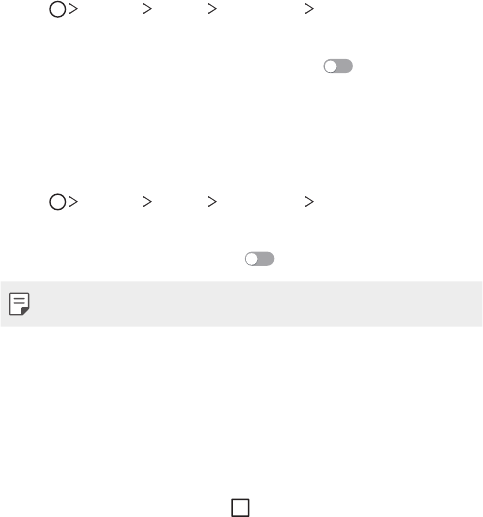
Custom-designed Features 16
Unlocking the screen with face recognition and then
screen swiping
With the screen turned off, you can unlock the screen by performing face
recognition and then swiping the screen.
1 Tap Settings Display Lock screen Face Recognition.
2 Unlock the screen according to the specified method.
3 Drag Swipe to unlock after face recognized to activate the
feature.
Enhancing the face recognition
You can prevent your device from being unlocked by photos, images, or
videos.
1 Tap Settings Display Lock screen Face Recognition.
2 Unlock the screen according to the specified method.
3 Drag Advanced face recognition to activate the feature.
• Face recognition speed may decrease when you activate this feature.
Multi-tasking feature
Multi window
You can use two apps at the same time by separating the screen into
multiple windows.
While using an app, touch and hold from the Home touch buttons,
then select an app from the recently-used apps list.
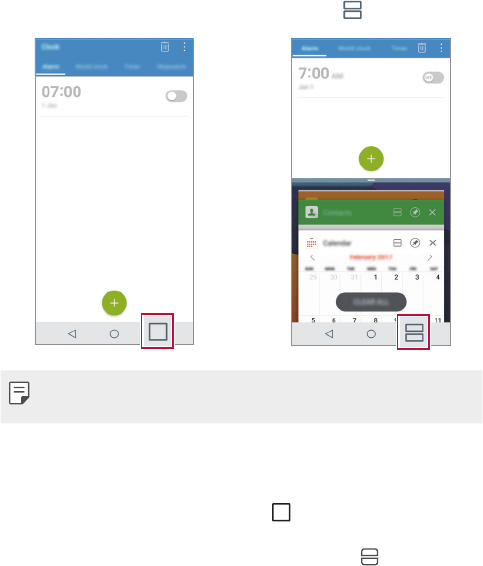
Custom-designed Features 17
• You can use two apps at the same time.
• To stop the Multi window feature, touch and hold .
• The Multi window feature is not supported by some apps, including
downloaded apps.
Overview screen
The Overview screen provides a preview of your recently-used apps.
To view the list of recently-used apps, tap on the Home touch buttons.
• Touch and hold an app and drag it to the top of the screen to start the
app with the Multi window feature. You can also tap at the top of
each app preview.
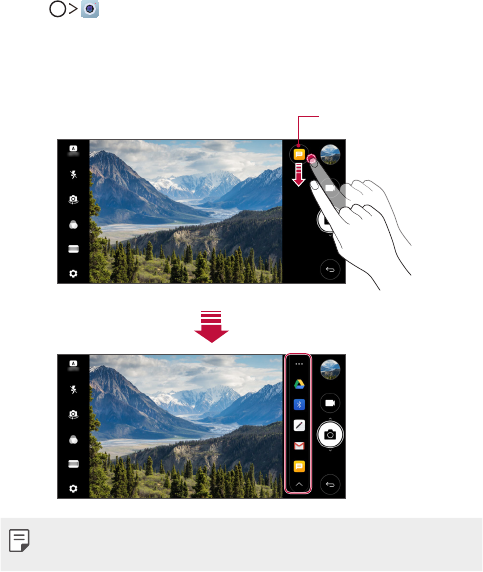
Custom-designed Features 18
quick share
You can share a photo or video to the app you want immediately after
taking it.
1 Tap , then take a photo or record a video.
2 Tap the app icon that appears on the screen to share it using that app.
You can also swipe the icon towards the opposite direction to see
what other apps you can use to share your photos and videos.
quick share icon
• The app displayed by the quick share icon may vary, depending on the
type and frequency of access to the apps installed on the device.

Basic Functions
02

Basic Functions 20
Product components and
accessories
The following items are included with your device.
• Device
• USB cable
• Charger
• Quick Start Guide
• Ejection pin
• The items described above may be optional.
• The items supplied with the device and any available accessories may
vary depending on the area and service provider.
• Always use genuine LG Electronics accessories. Using accessories made
by other manufacturers may affect your device's call performance or
cause malfunctions. This may not be covered by LG's repair service.
• If any of these basic items are missing, contact the dealer from which
you purchased your device.
• To purchase additional basic items, contact an LG Customer Service
Centre.
• To purchase optional items, contact an LG Customer Service Centre for
available dealers.
• Some items in the product box are subject to change without notice.
• The appearance and specifications of your device are subject to change
without notice.
• Device specifications may vary depending on the area or service provider.
• Be sure to use authentic accessories provided by LG Electronics. Using
third-party accessories may damage the device or cause malfunctions.

Basic Functions 21
Parts overview
Front camera lens
Proximity/Ambient light
sensor
Earpiece
Touch screen
Microphone
Stereo headset jack
Nano-SIM/Memory card tray
Microphone
Rear camera lens
Speaker
Charger/USB cable port
Flash
NFC area
Power/Lock key Volume keys (+/-)

Basic Functions 22
• Proximity/Ambient light sensor
- Proximity sensor: During a call, the proximity sensor turns off the
screen and disables touch functionality when the device is in close
proximity to the human body. It turns the screen back on and enables
touch functionality when the device is outside a specific range.
- Ambient light sensor: The ambient light sensor analyzes the ambient
light intensity when the auto-brightness control mode is turned on.
• Volume keys
- Adjust the volume for ringtones, calls or notifications.
- While using the Camera, gently press a Volume key to take a photo.
To take continuous shots of photos, press and hold the Volume key.
- Press the Volume Down (-) key twice to launch the Camera app
when the screen is locked or turned off. Press the Volume Up (+) key
twice to launch Capture+.
• Power/Lock key
- Briefly press the key when you want to turn the screen on or off.
- Press and hold the key when you want to select a power control
option.
• Your device has an internal rechargeable battery. For your safety, do not
remove the embedded battery.
• Some functions may be restricted for access, depending on the device
specifications.
• Do not put heavy objects on the device or sit on it. Doing so may
damage the touch screen.
• Screen-protective film or accessories may interfere with the proximity
sensor.
• If your device is wet or is being used in a humid place, the touch screen
or buttons may not function properly.

Basic Functions 23
Turning the power on or off
Turning the power on
When the power is turned off, press and hold the Power/Lock key.
• When the device is turned on for the first time, initial configuration
takes place. The first booting time for the smart phone may be longer
than usual.
Turning the power off
Press and hold the Power/Lock key, then select Power off.
Power control options
Press and hold the Power/Lock key, then select an option.
• Power off: Turn off the device.
• Power off and restart: Restart the device.
• Turn on Airplane mode: Block telecommunication-related functions,
including making phone calls, messaging and browsing the Internet.
Other functions remain available.
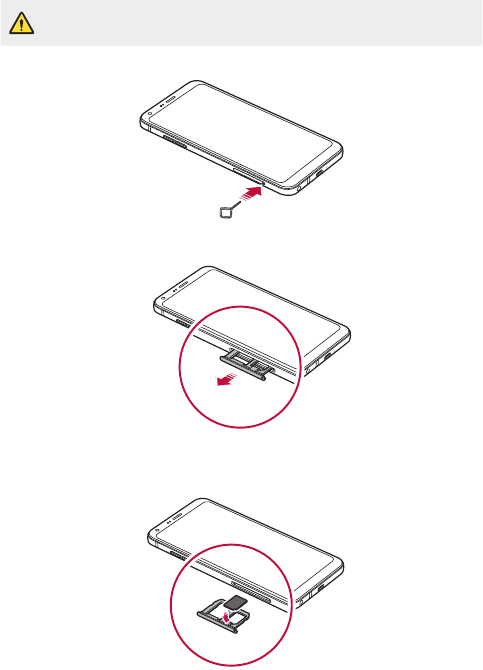
Basic Functions 24
Installing the SIM card
Insert the SIM card provided by your mobile service provider to start using
your device.
• Be careful with the ejection pin since it has a sharp edge.
1 Insert the ejection pin into the hole on the card tray.
2 Pull out the card tray.
3 Put the SIM card on the card tray with the gold-coloured contacts
facing downwards.
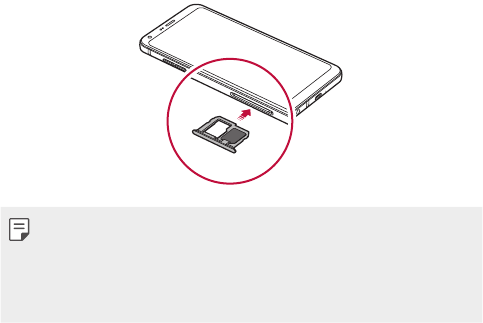
Basic Functions 25
4 Insert the card tray back into the slot.
• This device supports only Nano SIM cards.
• For problem-free performance, it is recommended to use the device
with the correct type of SIM card.
• If you insert the card tray into your device while the card tray is wet,
your device may be damaged. Always make sure the card tray is dry.
Precautions when using the SIM card
• Do not lose your SIM card. LG is not responsible for damage and other
issues caused by loss or transfer of a SIM card.
• Be careful not to damage the SIM card when you insert or remove it.
Inserting the memory card
Insert the memory card into your device.
The device can support up to a 2 TB microSD card. Depending on the
memory card manufacturer and type, some memory card may not be
compatible with your device.
1 Insert the ejection pin into the hole on the card tray.
2 Pull out the card tray.
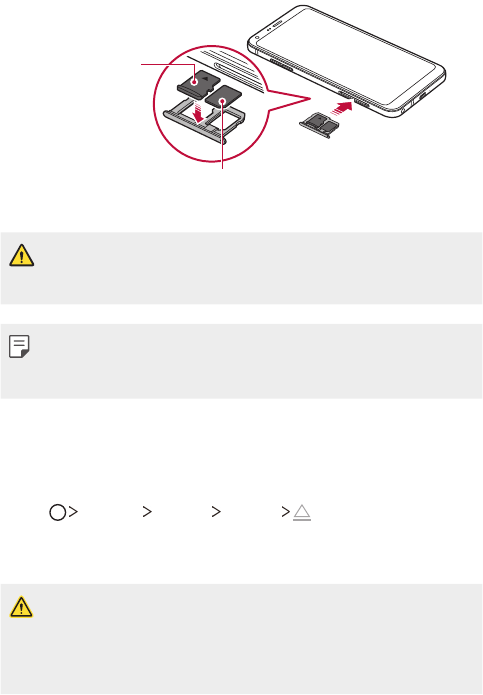
Basic Functions 26
3 Put the memory card on the card tray with the gold-coloured contacts
facing downwards.
SIM card
Memory card
4 Insert the card tray back into the slot.
• Some memory cards may not be fully compatible with the device. If you
use an incompatible card, it may damage the device or the memory card,
or corrupt the data stored in it.
• The memory card is an optional item and is sold separately.
• Frequent writing and erasing of data may shorten the memory card
lifespan.
Removing the memory card
Unmount the memory card before removing it for safety.
1 Tap Settings General Storage .
2 Insert the ejection pin into the hole on the card tray.
3 Pull out the card tray and remove the memory card.
• Do not remove the memory card while the device is transferring or
accessing information. This may cause data to be lost or corrupted, or
may damage the memory card or the device. LG is not responsible for
losses that result from the abuse or improper use of memory cards,
including the loss of data.
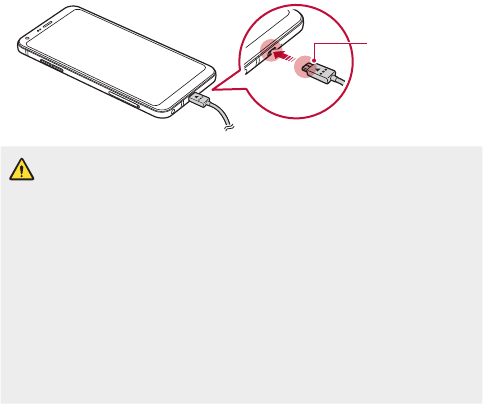
Basic Functions 27
Battery
Charging the battery
Before using the device, fully charge the battery.
Connect one end of the charging cable to the charger, insert the other end
of the cable into the cable port, and then plug the charger into a power
socket.
Charging cable
terminal
• Do not charge while the device or charging cable is wet or contains
moisture. This can cause fire, electric shock, injury or damage to device.
• Make sure to use the USB cable provided with your device.
• Make sure to use an LG-approved charger and charging cable. Charging
the battery with a third-party charger may cause the battery to explode
or may damage the device.
• Your device has an internal rechargeable battery. For your safety, do not
remove the embedded battery.
• Using the device when it is charging may cause electric shock. To use the
device, stop charging it.
• This device is also compatible with wireless charging devices approved
by LG, which are sold separately.

Basic Functions 28
• Remove the charger from the power socket after the device is fully
charged. This prevents unnecessary power consumption.
• Another way to charge the battery is by connecting a USB cable
between the device and a desktop or laptop computer. This may take a
longer time than plugging the adapter to a wall outlet.
• Do not charge the battery by using a USB hub that is unable to maintain
the rated voltage. Charging may fail or unintentionally stop.
Precautions when using the device
• Ensure that the inside of the device does not make contact with a
metallic object or water.
• Make sure to use the USB cable provided; do not use third party USB
cables or chargers with your device. The LG limited warranty does not
cover the use of third party accessories.
• Failure to follow the instructions in this guide and improper use may
damage the device.
Using the battery efficiently
Battery lifespan may decrease if you keep many apps and functions
running simultaneously and continuously.
Stop apps and functions from running in the background to increase
battery life.
To minimize battery consumption, follow these tips:
• Turn off the Bluetooth® or Wi-Fi network function when not using
them.
• Set the screen timeout to as short a time as possible.
• Minimize the screen brightness.
• Set a screen lock when the device is not used.
• Check the battery usage details and close any downloaded apps that
are draining the battery.

Basic Functions 29
Touch screen
You can familiarize yourself with how to control your device by using
touch screen gestures.
Tapping
Lightly tap with your fingertip to select or run an app or option.
Touching and holding
Touch and hold for several seconds to display a menu with available
options.

Basic Functions 30
Double-tapping
Tap twice quickly to zoom in or out on a web page or map.
Dragging
Touch and hold an item, such as an app or widget, then move your finger
to another location in a controlled motion. You can use this gesture to
move an item.
Swiping
Touch the screen with your finger and move it quickly without pausing.
You can use this gesture to scroll through a list, a web page, photos,
screens, and more.
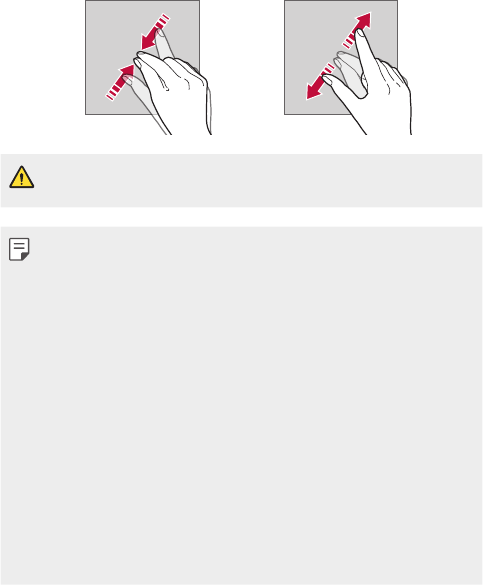
Basic Functions 31
Pinching and spreading
Pinch two fingers to zoom out such as on a photo or map. To zoom in,
spread your fingers apart.
• Do not expose the touch screen to excessive physical shock. You might
damage the touch sensor.
• A touch screen failure may occur if you use the device near a magnetic,
metallic or conductive material.
• If you use the device under bright lights, such as direct sunlight, the
screen may not be visible, depending on your position. Use the device
in a shady location or a location with an ambient light that is not too
bright and bright enough to read books.
• Do not press the screen with excessive force.
• Gently tap with your fingertip on the option you want.
• The touch control may not work properly if you tap while wearing a
glove or by using the tip of your fingernail.
• Touch control may not work properly if the screen is moist or wet.
• The touch screen may not function properly if a screen-protective film
or accessory purchased from a third party store is attached to the
device.
• Displaying a static image for extended periods of time may result in
afterimages or screen burn-in. Turn off the screen when you do not use
the device for a long time.
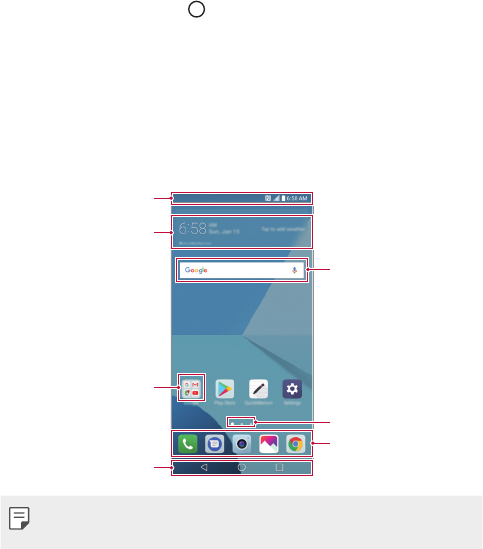
Basic Functions 32
Home screen
Home screen overview
The Home screen is the starting point for accessing various functions
and apps on your device. Tap on any screen to directly go to the Home
screen.
You can manage all apps and widgets on the Home screen. Swipe the
screen left or right to view all installed apps at a glance.
Home screen layout
You can view all apps and organize widgets and folders on the Home
screen.
Quick access area
Home touch buttons
Folder
Status bar
Weather widget
Page icon
Google search widget
• The Home screen may vary, depending on the service provider or
software version.
• Status bar: View status icons, the time and the battery level.
• Weather widget: View the weather information and time for a specific
area.
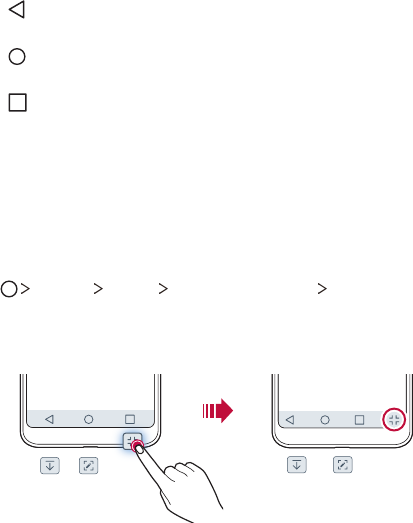
Basic Functions 33
• Google search widget: Perform a Google search by inputting spoken
or written keywords.
• Folder: Create folders to group apps by your preferences.
• Page icon: Display the total number of Home screen canvases. Tap the
desired page icon to go to the page you selected. The icon reflecting
the current canvas will be highlighted.
• Quick access area: Fix main apps at the bottom of the screen so that
they can be accessed from any Home screen canvas.
• Home touch buttons
- : Return to the previous screen. Close the keypad or pop-up
windows.
- : Tap to go to the Home screen. To launch Google search, touch
and hold.
- : Tap to view a list of recently used apps or run an app from the
list. To delete all the recently used apps, tap CLEAR ALL. To use two
apps at the same time with the Multi-Window feature, touch and
hold the button while using an app.
Editing the Home touch buttons
You can rearrange the Home touch buttons or add frequently used
functions to the Home touch buttons area.
Tap Settings Display Home touch buttons Button
combination and customize the settings.
• Several functions, including Notification panel and Capture+, are
provided. A maximum of five items can be added.
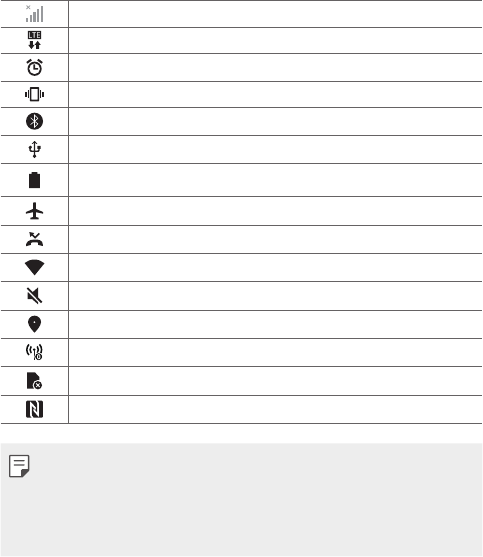
Basic Functions 34
Status icons
When there is a notification for an unread message, calendar event or
alarm, the status bar displays the corresponding notification icon. Check
your device's status by viewing notification icons displayed on the status
bar.
No signal
Data is being transmitted over the network
Alarm is set
Vibrate mode is on
Bluetooth is on
Connected to a computer via USB
Battery level
Airplane mode is on
Missed calls
Wi-Fi is connected
Mute mode is on
GPS is on
Hotspot is on
No SIM card
NFC is on
• Some of these icons may appear differently or may not appear at all,
depending on the device's status. Refer to the icons according to the
actual environment and area in which you are using the device and your
service provider.
• Displayed icons may vary, depending on the area or service provider.
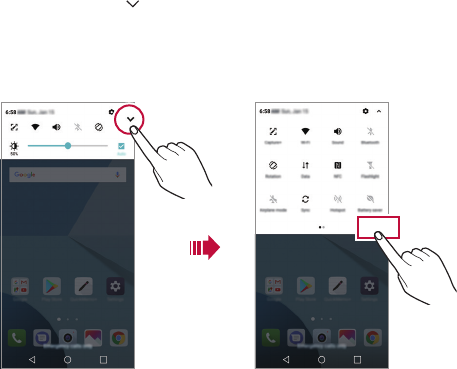
Basic Functions 35
Notifications panel
You can open the notifications panel by dragging the status bar
downward on the main screen.
• To open the quick access icons list, drag the notifications panel
downwards or tap .
• To rearrange, add, or remove icons, tap EDIT.
• If you touch and hold the icon, the settings screen for the
corresponding function appears.
EDIT
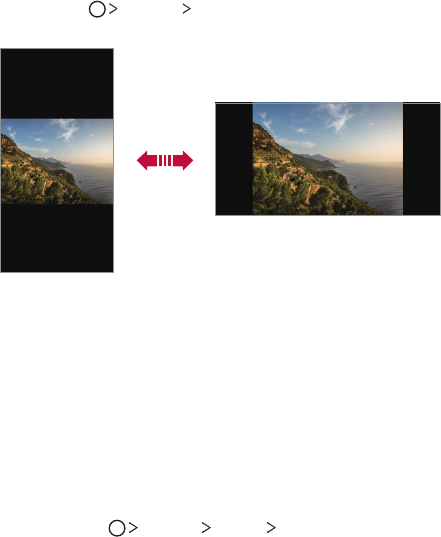
Basic Functions 36
Switching the screen orientation
You can set the screen orientation to automatically switch according to
the device's physical orientation.
On the notification panel, tap Rotation from the quick access icon list.
You can also tap Settings Display and activate Auto-rotate
screen.
Editing the Home screen
On the Home screen, touch and hold on an empty space, then select the
desired action from below.
• To rearrange the Home screen canvases, touch and hold on a canvas,
then drag it to another location.
• To add a widget to the Home screen, touch and hold on a blank area of
the Home screen, then select Widgets.
• To change a theme, touch and hold on a blank area of the Home
screen, then select Theme.
You can also tap Settings Display Theme, then select a theme
to apply to the device.
• To configure the Home screen settings, touch and hold on a blank area
of the Home screen, then select Home screen settings. See
Home
screen settings
for details.
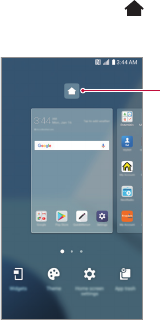
Basic Functions 37
• To view or reinstall the uninstalled apps, touch and hold on a blank area
of the Home screen, then select App trash. See
App trash
for details.
• To change the default screen, touch and hold on a blank area of the
Home screen, move to desired screen, tap , then tap the screen once
more.
Default screen
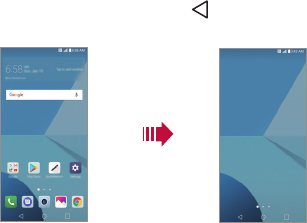
Basic Functions 38
Viewing the background theme
You can view only the background image by hiding the apps and widgets
on the Home screen.
Spread two fingers apart on the Home screen.
• To return to the original screen, which displays apps and widgets, pinch
your fingers on the Home screen or tap .

Basic Functions 39
Moving apps on the Home screen
On the Home screen, touch and hold an app, then drag it to another
location.
• To keep frequently used apps at the bottom of the Home screen, touch
and hold an app, then drag it to the quick access area at the bottom.
• To remove an icon from the quick access area, drag the icon to the
Home screen.
Using folders from the Home screen
Creating folders
On the Home screen, touch and hold an app, then drag it over another
app.
• A new folder is created and the apps are added to the folder.
Editing folders
On the Home screen, tap a folder and do one of the following actions.
• To edit the folder name and colour, tap the folder name.
• To add apps, touch and hold an app, then drag it over the folder and
release it.
• To remove an app from the folder, touch and hold the app and drag it
to outside the folder. If there is only one app remaining in the folder, the
folder is removed automatically.
• You can also add or remove apps after tapping in the folder.

Basic Functions 40
Home screen settings
You can customize Home screen settings.
1 Tap Settings Display Home screen.
2 Customize the following settings:
• Select Home: Select a Home screen mode.
• Wallpaper: Change the Home screen background wallpaper.
• Screen swipe effect: Select an effect to apply when the Home
screen canvas switches.
• Icon shapes: Choose if you want icons to have square or rounded
corners.
• Sort apps by: Set how apps are sorted on the Home screen.
• Grid: Change the app arrangement mode for the Home screen.
• Hide apps: Select which apps you want to hide from the Home
screen.
• Continuous loop: Enable to allow continuous Home screen scrolling
(loop back to first screen after the last screen).
• Search: Search by swiping down on the Home screen.
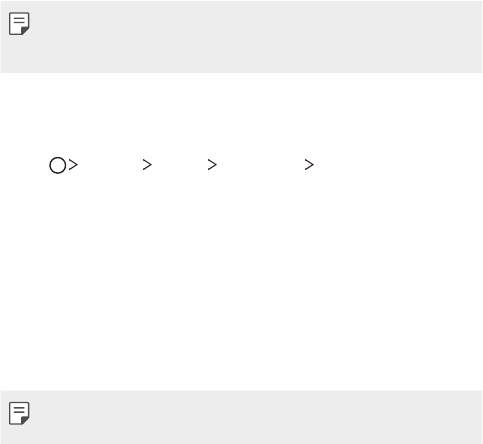
Basic Functions 41
Screen lock
Screen lock overview
Your device's screen turns off and locks itself if you press the Power/Lock
key. This also happens after the device is left idle for a specified period of
time.
If you press the Power/Lock key when a screen lock is not set, the Home
screen appears immediately.
To ensure security and prevent unwanted access to your device, set a
screen lock.
• Screen lock prevents unnecessary touch input on the device screen and
reduces battery consumption. We recommend that you activate the
screen lock while not using the device.
Setting a screen lock settings
There are several options available for configuring the screen lock settings.
1 Tap Settings Display Lock screen Select screen lock and
then select the method you prefer.
2 Customize the following settings:
• None: Deactivate the screen lock function.
• Swipe: Swipe on the screen to unlock the screen.
• Pattern: Draw a pattern to unlock the screen.
• PIN: Enter a numeric password to unlock the screen.
• Password: Enter an alphanumeric password to unlock the screen.
• Allow face recognition: Unlock the screen by recognising your face.
• If you incorrectly attempt to unlock the device 5 times, the screen is
blocked for 30 seconds.

Basic Functions 42
Secure start-up settings
When you select Pattern, PIN or Password as a screen lock method, you
can configure your device to be locked whenever turning on the device in
order to secure your data.
• You cannot use all functions, except for emergency calls, until you
unlock the device.
• If you forget your decryption password, you cannot restore encrypted
data and personal information.
Lock screen settings
You can customize the following lock screen settings.
1 Tap Settings Display Lock screen.
2 Customize the following settings:
• Select screen lock: Select a screen lock method.
• Face Recognition: Unlock the lock screen by recognising your face.
See
Face recognition overview
for details.
• Smart Lock: Select trusted items so that if you are connected to or
near one, the device is automatically unlocked.
• Wallpaper: Change the lock screen background wallpaper.
• Clock: Select the position of the clock on the lock screen.
• Shortcuts: Add an app shortcut and directly access the app from
the lock screen by dragging the app shortcut.
• Screen swipe effect: Set screen transition effects to apply when
the screen is unlocked.
• Contact info for lost phone: Display emergency contact
information on the lock screen.
• Lock timer: Set the amount of idle time after which the device
automatically locks.
• Power key instantly locks: Instantly lock the screen when the
Power/Lock key is pressed.

Basic Functions 43
• Available setting items may vary, depending on the selected screen lock
method.
KnockON
You can turn the screen on or off by double-tapping the screen.
• This option is available only on the Home screen provided by LG. It may
not function properly on a custom launcher or on the Home screen
installed by the user.
• When tapping the screen, use your fingertip. Do not use a fingernail.
• To use the KnockON feature, make sure that the proximity/light sensor
is not blocked by a sticker or any other foreign substance.
Turning on the screen
Double-tap the middle of the screen.
• Tapping the top or bottom of the screen may decrease the recognition
rate.
Turning off the screen
Double-tap on an empty space on the screen.
You can also double-tap an empty space on the status bar.
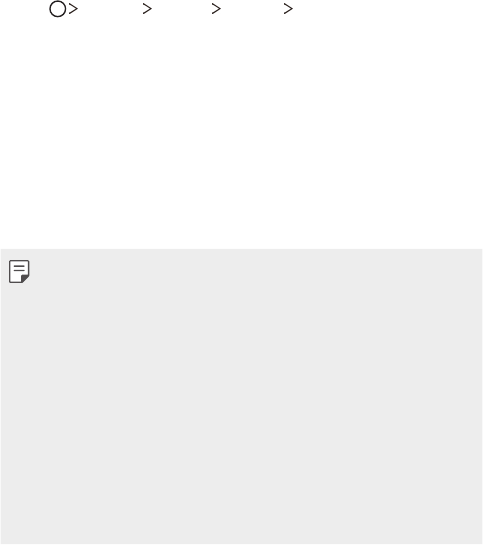
Basic Functions 44
Memory card encryption
You can encrypt and protect data saved on the memory card. The
encrypted data in the memory card cannot be accessed from another
device.
1 Tap Settings General Security Encrypt SD card.
2 Read the on-screen overview of memory card encryption and then tap
CONTINUE to continue.
3 Select an option and tap ENCRYPT NOW.
• New data encryption: Encrypt only data that is saved on the
memory card after encryption.
• Full encryption: Encrypt all the data currently saved on the memory
card.
• Exclude media files: Encrypt all files, except for media files such as
music, photos and videos.
• To encrypt the memory card, make sure that a screen lock is set using a
PIN or password.
• Once memory card encryption starts, some functions are not available.
• If the device is turned off while encryption is underway, the encryption
process will fail, and some data may be damaged. Therefore, be sure to
check that the battery level is sufficient before starting encryption.
• Encrypted files are accessible only from the device where the files were
encrypted.
• The encrypted memory card cannot be used on another LG device. To
use the encrypted memory card on another mobile device, format the
card.
• You can activate memory card encryption even when no memory card
is installed into the device. Any memory card that is installed after
encryption will automatically be encrypted.

Basic Functions 45
Taking screenshots
You can take screenshots of the current screen you are viewing.
Via a shortcut
Press and hold the Power/Lock key and the Volume Down (-) key at the
same time for at least two seconds.
• Screenshots can be viewed from the Screenshots folder in the
Gallery.
Via Capture+
On the screen where you want to take a screenshot, drag the status bar
downwards, then tap .
• When the screen is turned off or locked, you can access Capture+ by
pressing the Volume Up (+) key twice. To use this feature, tap
Settings General and turn on Shortcut keys.
• See
Writing notes on a screenshot
for details.
Entering text
Using the Smart keyboard
You can use the Smart keyboard to enter and edit text.
With the Smart keyboard, you can view text as you type without
bothering to alternate between the screen and a conventional keyboard.
This allows you to easily find and correct errors when typing.
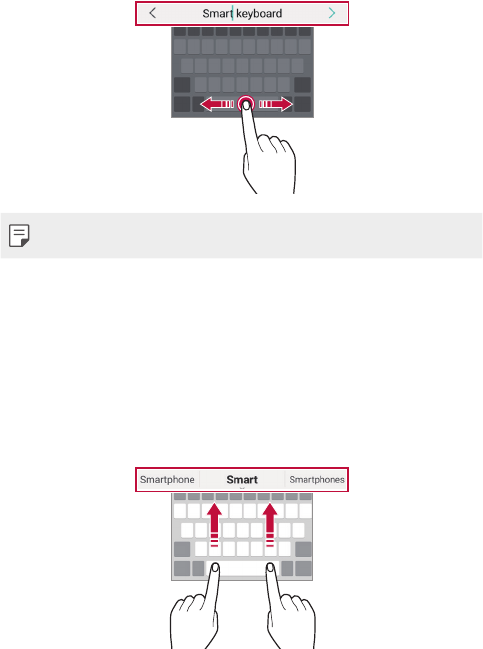
Basic Functions 46
Moving the cursor
With the Smart keyboard, you can move the cursor to the exact position
you want. When typing text, touch and hold on the space bar and then
drag left or right.
• This function may not be supported for some languages.
Suggesting words
Smart keyboard automatically analyzes your usage patterns to suggest
frequently used words as you type. The longer you use your device, the
more precise the suggestions are.
Enter text, then tap a suggested word or gently drag the left or right side
of the keyboard upwards.
• The selected word is automatically entered. You do not need to
manually type every letter of the word.
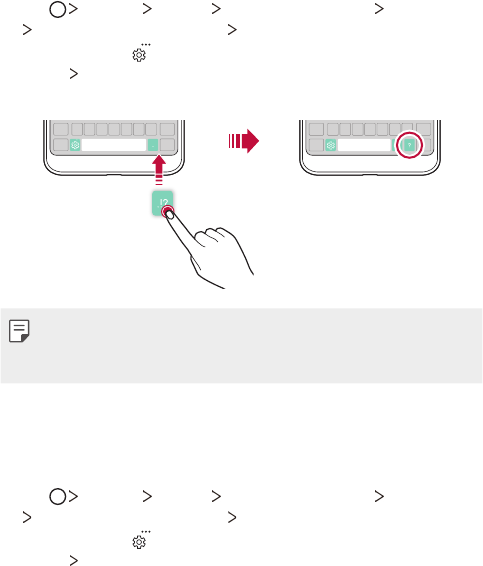
Basic Functions 47
Changing the QWERTY keyboard layout
You can add, delete or rearrange keys on the bottom row of the keyboard.
1 Tap Settings General Language & keyboard LG Keyboard
Keyboard height and layout QWERTY layout.
You can also tap on the keyboard and tap Keyboard height and
layout QWERTY layout.
2 Tap a key on the bottom row, then drag it to another position.
• This option is available on the QWERTY, QWERTZ and AZERTY
keyboards.
• This function may not be supported for some languages.
Customizing the keyboard height
You can customize the keyboard height to maximize hand comfort when
typing.
1 Tap Settings General Language & keyboard LG Keyboard
Keyboard height and layout Keyboard height.
You can also tap on the keyboard and tap Keyboard height and
layout Keyboard height.
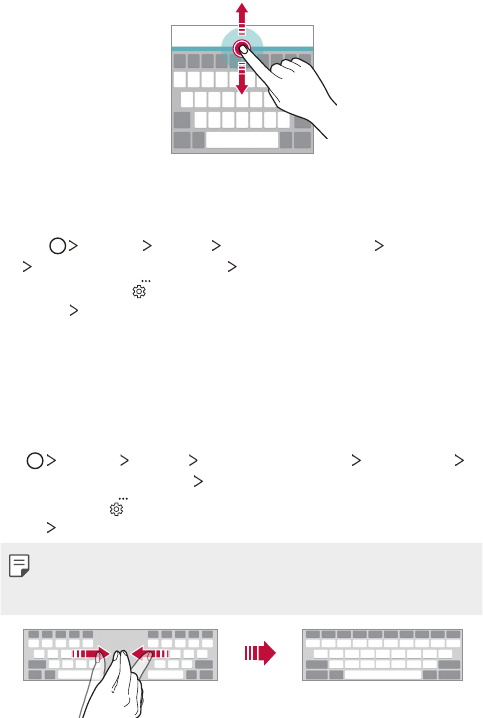
Basic Functions 48
2 Adjust the keyboard height.
Selecting a landscape keyboard mode
You can select a landscape keyboard mode from several choices.
1 Tap Settings General Language & keyboard LG Keyboard
Keyboard height and layout Keyboard type in landscape.
You can also tap on the keyboard and tap Keyboard height and
layout Keyboard type in landscape.
2 Select a keyboard mode.
Splitting the keyboard
You can split the keyboard in half and place each piece on either side of
the screen when the screen is in landscape mode.
Tap Settings General Language & keyboard LG Keyboard
Keyboard height and layout Split keyboard.
You can also tap on the keyboard and tap Keyboard height and
layout Split keyboard.
• Rotate the device to landscape mode to split the keyboard to both sides.
To merge or split the keyboard, pinch together or spread apart your
fingers on the keyboard.
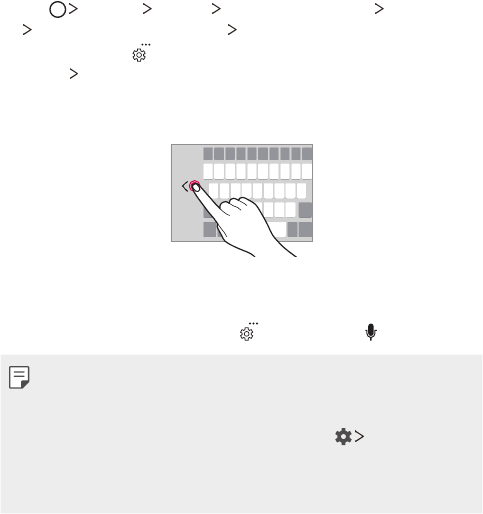
Basic Functions 49
One-handed operation mode
You can move the keyboard to one side of the screen so that you can use
the keyboard with one hand.
1 Tap Settings General Language & keyboard LG Keyboard
Keyboard height and layout One-handed operation.
You can also tap on the keyboard and tap Keyboard height and
layout One-handed operation.
2 Press the arrow displayed next to the keyboard to move the keyboard
in the direction you want.
Entering text by using voice
On the keyboard, tap touch and hold and then select .
• To maximize the voice command recognition, speak clearly.
• To enter text with your voice, make sure that your device is connected
to a network.
• To select the language for voice recognition, tap Languages on the
voice recognition screen.
• This function may be not supported, or the supported languages may
differ depending on the service area.
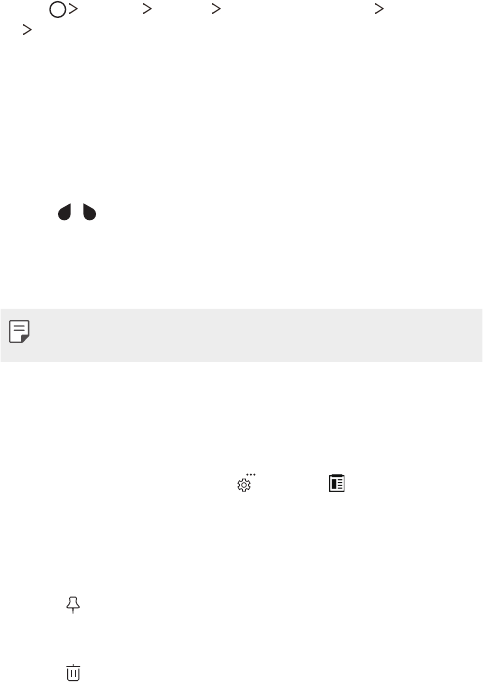
Basic Functions 50
Adding languages to the keyboard
You can make additional languages available for keyboard input.
1 Tap Settings General Language & keyboard LG Keyboard
Select languages.
2 Select the languages you want to make available.
Copy and Paste
You can cut or copy text from an app, and then paste the text into the
same app. Or, you can run other apps and paste the text into them.
1 Touch and hold around the text you want to copy or cut.
2 Drag / to specify the area to copy or cut.
3 Select either CUT or COPY.
• Cut or copied text is automatically added to the clipboard.
4 Touch and hold the text input window, then select PASTE.
• If there is no item that has been copied or cut, the PASTE option will
not appear.
Clip Tray
If you copy or cut an image or text, it is automatically saved to the clip tray
and can be pasted to any space at any time.
1 On the keyboard, touch and hold and select .
You can also touch and hold the text input window, then select CLIP
TRAY.
2 Select and paste an item from the clip tray.
• A maximum of 20 items can be saved to the clip tray.
• Tap to lock saved items in order not to delete them, even when
the maximum quantity is exceeded. A maximum of ten items can be
locked. To delete locked items, unlock them first.
• Tap to delete the items saved to the clip tray.
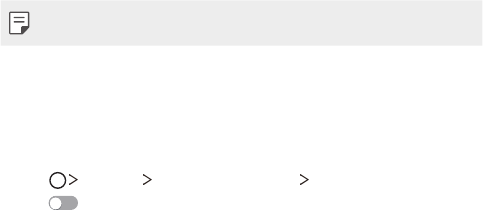
Basic Functions 51
• The clip tray may not be supported by some downloaded apps.
Do not disturb
You can limit or mute notifications to avoid disturbances for a specific
period of time.
1 Tap Settings Sound & notification Do not disturb and then
tap to activate it.
2 Tap Sounds and vibrations and select the mode you want:
• Priority only: Receive sound or vibrate notifications for the selected
apps. Even when Priority only is turned on, alarms still sound.
• Total silence: Disable both the sound and vibration.

Useful Apps
03
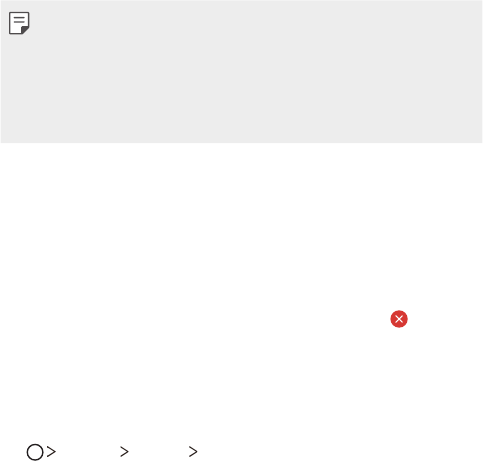
Useful Apps 53
Installing and uninstalling apps
Installing apps
Access an app store to search and download apps.
• You can use the SmartWorld, Play Store or the app store provided by
your service provider.
• Some app stores may require you to create an account and sign in.
• Some apps may charge fees.
• If you use mobile data, you may be charged for data usage, depending
on your pricing plan.
• SmartWorld may not be supported depending on the area or service
provider.
Uninstalling apps
Uninstall apps that you no longer use from your device.
Uninstalling with the touch and hold gesture
On the Home screen, touch and hold the app to uninstall, then drag it over
Delete at the top of the screen.
You can also touch and hold the app and release it, then tap to
uninstall.
• If apps were uninstalled within 24 hours from now, you can reinstall
them. See
App trash
for details.
Uninstalling by using the settings menu
Tap Settings General Apps, select an app, then tap Uninstall.
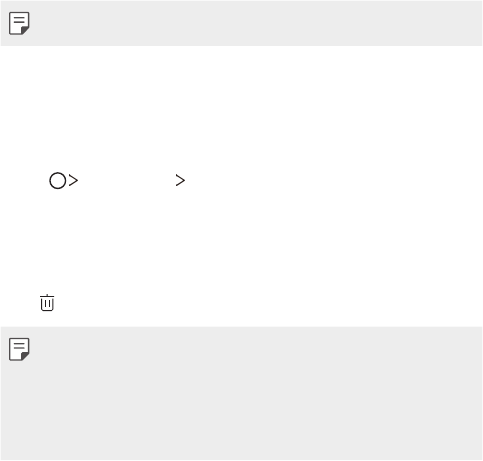
Useful Apps 54
Uninstalling apps from the app store
To uninstall an app, access the app store from which you download the
app and uninstall it.
• Some apps cannot be uninstalled by users.
App trash
You can view the uninstalled apps on the Home screen. You can also
reinstall apps which were uninstalled within 24 hours from now.
1 Tap Management App trash.
Alternatively, You can also touch and hold an empty area of the Home
screen, then tap App trash.
2 Activate the desired function:
• Restore: Reinstall the selected app.
• : Remove the uninstalled apps permanently from the device.
• Uninstalled apps are automatically removed from the device 24 hours
after they were uninstalled. If you want to reinstall the uninstalled apps,
you must download them again from the app store.
• This feature is activated on the default Home screen only. If you
uninstall apps while using the EasyHome screen or other launcher, they
are immediately and permanently removed from the device.
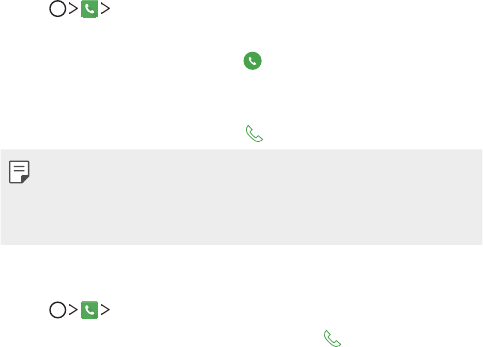
Useful Apps 55
Phone
Voice call
Make a phone call by using one of the available methods, such as manually
entering a phone number and making a call from the contact list or the
list of recent calls.
Making a call from the keypad
1 Tap Dial.
2 Make a call by using a method of your choice:
• Enter a phone number and tap .
• Touch and hold a speed dial number.
• Search for a contact by tapping the initial letter of a contact name
in the contact list, and then tap .
• To enter "+" when making an international call, touch and hold number
0.
• See
Adding contacts
for details on how to add phone numbers to the
speed dial list.
Making a call from the contact list
1 Tap Contacts.
2 From the contact list, select a contact and tap .
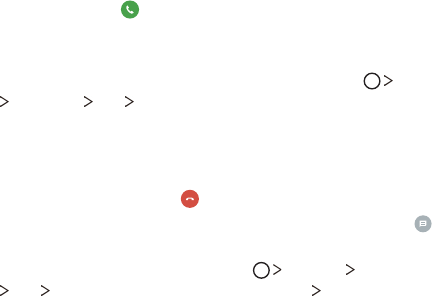
Useful Apps 56
Answering a call
To answer a call, drag on the incoming call screen.
• When the stereo headset is connected, you can make calls by using the
call/end button on the headset.
• To end a call simply by pressing the Power/Lock key, tap Settings
Networks Call Answer and end calls, then turn on End call
with the Power key.
Rejecting a call
To reject an incoming call, drag across the incoming call screen.
• To send a rejection message, drag the rejection message option
across the screen.
• To add or edit a rejection message, tap Settings Networks
Call Call blocking & Decline with message Decline with
message.
• When a call is coming in, press the Volume Up (+), Volume Down (-) or
Power/Lock key to mute ringtone or vibration, or to hold the call.
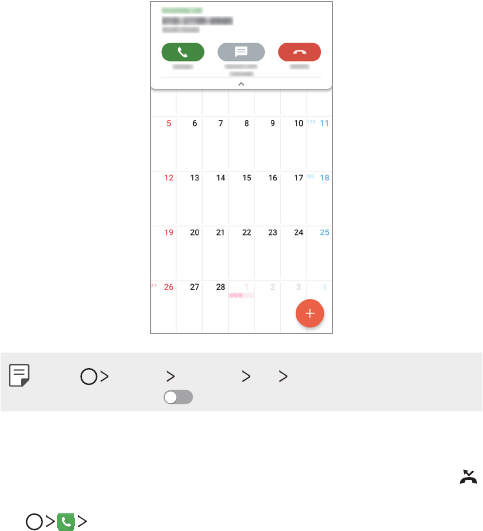
Useful Apps 57
Checking an incoming call while using an app
When a call comes in while using an app, a pop-up notification can be
displayed at the top of the screen. You can receive the call, reject the call,
or send message from the pop-up screen.
• Tap Settings Networks Call More and then tap Incoming
voice call pop-up to deactivate it.
Viewing missed calls
If there is a missed call, the status bar at the top of the screen displays .
To view missed call details, drag the status bar downwards. You can also
tap Call logs.
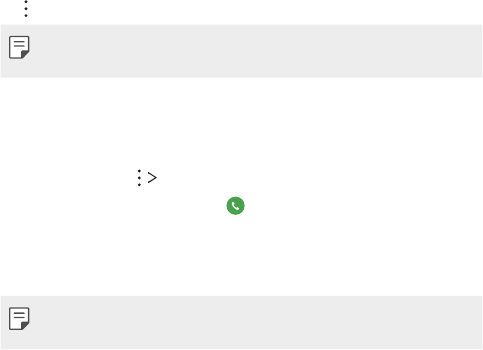
Useful Apps 58
Functions accessible during a call
During a call, you can access a variety of functions by tapping the on-
screen buttons:
• Contacts: View the contact list during a call.
• End: End a call.
• Dialpad: Display or hide the dial pad.
• Speaker: Turn on the speakerphone function.
• Mute: Mute your voice so that your voice cannot be heard by the other
party.
• Bluetooth: Switch the call to a Bluetooth device that is paired and
connected.
• : Access additional call options.
• Available settings items may vary depending on the area or service
provider.
Making a three-way calling
You can make a call to another contact during a call.
1 During a call, tap Add call.
2 Enter a phone number and tap .
• The two calls are displayed on the screen at the same time, and the
first call is put on hold.
3 To start a conference call, tap Merge calls.
• You may be charged a fee for each call. Consult with your service
provider for more information.
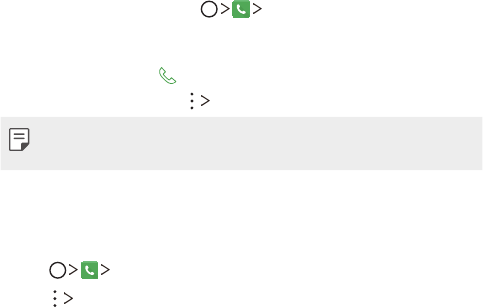
Useful Apps 59
Viewing call records
To view recent call records, tap Call logs. Then, you can use the
following functions:
• To view detailed call records, select a contact. To make a call to the
selected contact, tap .
• To delete call records, tap Delete.
• The displayed call duration may differ from the call charge. Consult with
your service provider for more information.
Configuring call options
You can configure various call options.
1 Tap Dial or Call logs.
2 Tap Call settings and then configure the options to suit your
preferences.
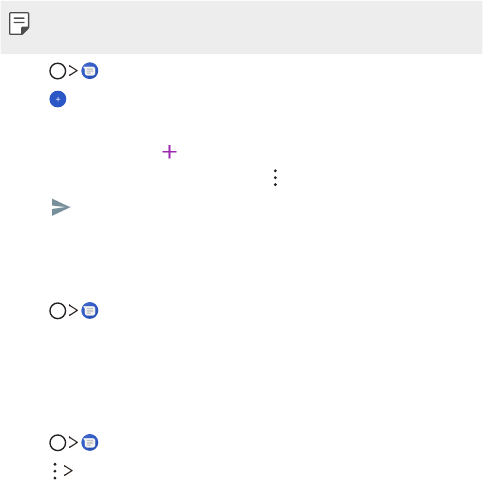
Useful Apps 60
Messaging
Sending a message
You can create and send messages to your contacts using the Messaging
app.
• Sending messages abroad may incur additional charges. Consult with
your service provider for more information.
1 Tap .
2 Tap .
3 Specify a recipient and create a message.
• To attach files, tap .
• To access optional menu items, tap .
4 Tap to send the message.
Reading a message
You can view exchanged messages organized by contact.
1 Tap .
2 Select a thread from the thread list.
Configuring messaging settings
You can change messaging settings to suit your preferences.
1 Tap .
2 Tap Settings from the message list.
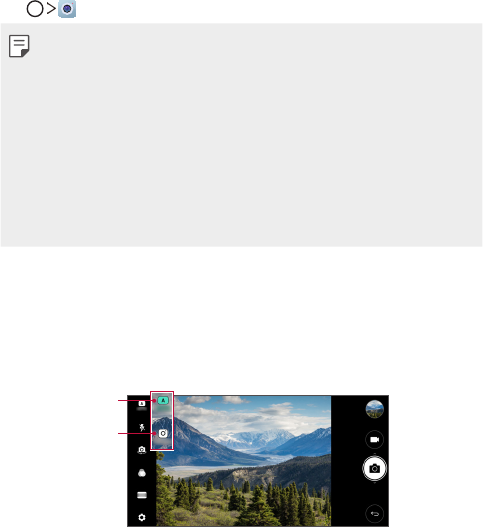
Useful Apps 61
Camera
Starting the camera
You can take a photo or record a video to cherish all of your memorable
moments.
Tap .
• Before taking a photo or recording a video, wipe the camera lens with a
soft cloth.
• Be careful not to stain the camera lens with your fingers or other
foreign substance.
• If the battery level is lower than 5%, charge the battery before using
the camera.
• Images included in this user guide may be different from the actual
device.
• Photos and videos can be viewed or edited from the Gallery. See
Gallery
overview
for details.
Changing the camera mode
You can select a camera mode that suits your environment to take a
photo or record a video easily and conveniently.
On the camera screen, select AUTO mode and choose the desired mode.
AUTO mode
Square mode
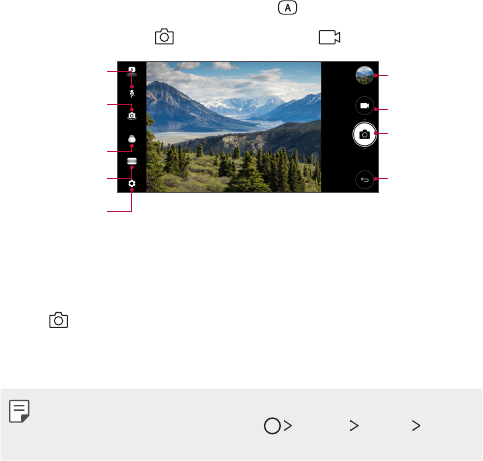
Useful Apps 62
Auto mode
You can take photos or record videos by selecting a variety of camera
modes and options.
1 Launch the Camera app, select AUTO ( ).
2 To take a photo, tap . To record a video, tap .
Turn the flash on
or off.
Switch between
front and rear
cameras.
Apply a film filter
effect.
Select a camera
mode.
Change the camera
options.
Start the Gallery.
Record videos.
Take photos.
Back to the
previous screen.
Taking a photo
1 Select a camera mode and tap the subject to focus the camera on.
2 Tap to take a photo.
• You can also press the Volume Down (-) or Volume Up (+) key to
take a photo.
• When the screen is turned off or locked, start the camera by pressing
the Volume Down (-) key twice. Tap Settings General
Shortcut keys.
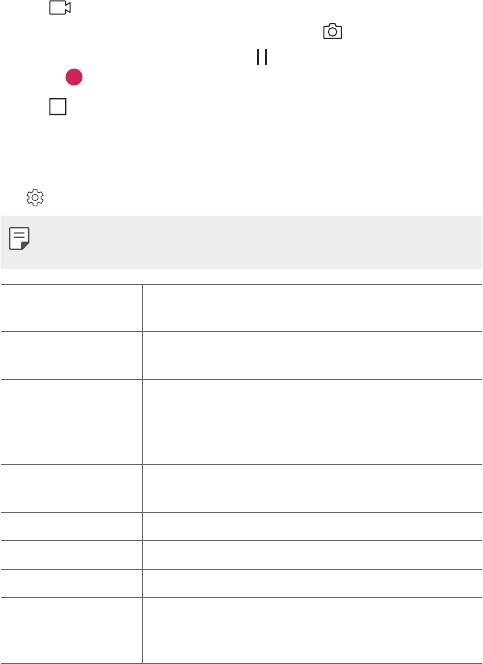
Useful Apps 63
Recording a video
1 Select a camera mode and tap the subject to focus the camera on.
2 Tap .
• To take a photo while recording a video, tap .
• To pause the video recording, tap . To resume the video recording,
tap .
3 Tap to end the video recording.
Customizing the camera options
You can customize a variety of camera options to suit your preferences.
Tap on the screen.
• Available options vary depending on the selected camera (front or rear
camera) and the selected camera mode.
Photo size Select the desired value for the aspect ratio and size of
your photos.
Video resolution Select the desired value for resolution and size of your
videos.
HDR
Obtain photos in vivid colours and get compensated
effects even when they are taken against the light.
These functions are provided by the high dynamic range
(HDR) technology equipped in the camera.
Timer Set the timer to automatically take photos after a
specified period of time.
Cheese shutter Take photos with voice commands.
Steady recording Minimize motion blur while recording a video.
Tag locations Save the image with GPS location data.
Grid
Display guide grids to so that you can take photos
or record videos based on the horizontal and vertical
reference lines.
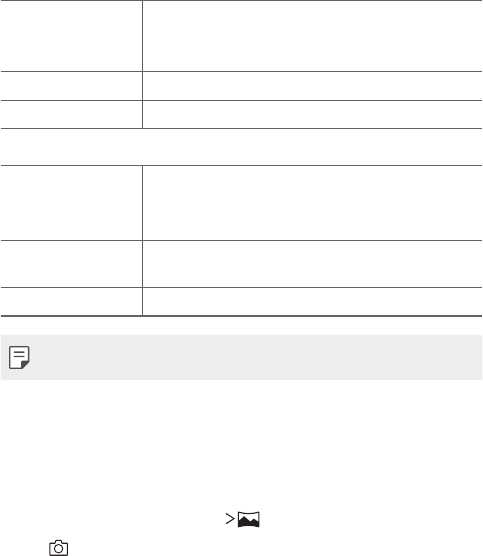
Useful Apps 64
Storage
Select if you want to store the pictures and videos in
the Internal storage or SD card.
(Available when the memory card is inserted.)
Simple view Hide all menus from the camera screen.
Help Provide help information for each camera menu.
Additional options on the front camera
Selfie shot
Customize the selfie shot settings.
•Gesture shot: Shoot using the Gesture shot feature.
•Auto shot: Shoot when the camera detects a face.
Gesture view Choose whether to use Gesture view to view the taken
photo immediately after taking a photo.
Save as flipped Save as flipped images after taking selfies.
• When using the front camera, you can adjust the filter and skin tone.
Various camera modes
Panorama
You can create a panoramic photo by moving the camera in one direction
to photograph and stitch continuous shots of a wide view.
1 In the AUTO mode, tap MODE .
2 Tap and then slowly move the camera in one direction.
• Move the device by following the direction of the arrow in the
guideline.
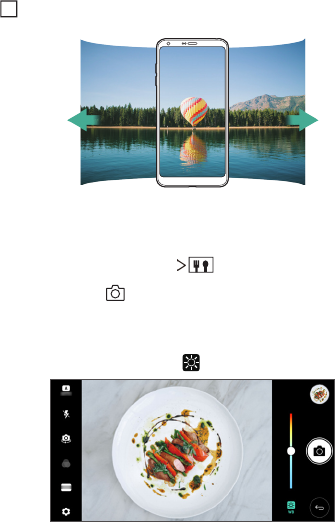
Useful Apps 65
3 Tap to stop capturing the panoramic.
Food
You can take a photo using the control slide bar on the right of the screen.
1 In the AUTO mode, tap MODE .
2 To take a photo, tap .
• Drag the colour slide bar on the screen to adjust the white balance
and select the best colour.
• If the slide bar is invisible, tap to adjust the white balance.
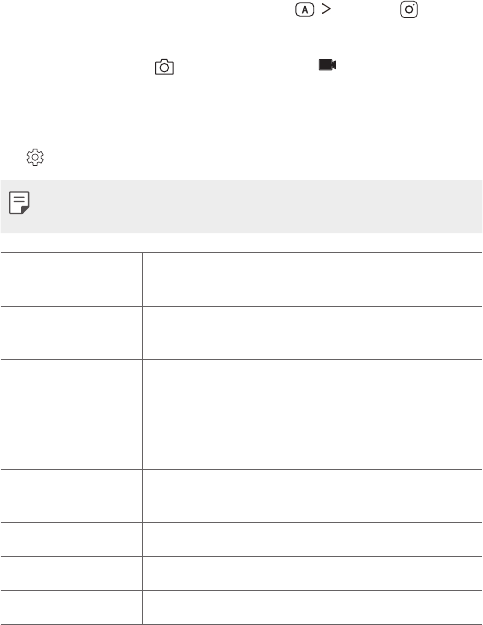
Useful Apps 66
Square mode
You can take multiple photos or videos in the form of a collage by using
the front and rear cameras. Photos and videos can be saved with different
layouts.
1 Launch the Camera app, then tap AUTO ( ) SQUARE().
2 Tap MODE and select the desired camera mode.
3 To take a photo, tap . To record a video, tap .
Customizing the camera options
You can customize a variety of camera options to suit your preferences.
Tap on the screen.
• Available options vary depending on the selected camera (front or rear
camera) and the selected camera mode.
Photo size Select the desired value for the aspect ratio and size of
your photos.
Video resolution Select the desired value for the resolution and size of
your videos.
HDR
Obtain photos in vivid colours and get compensated
effects even when they are taken against the light.
These functions are provided by the high dynamic
range (HDR) technology equipped in the device’s
camera.
Timer Set the timer to automatically take photos after a
specified period of time.
Cheese shutter Take photos with voice commands.
Steady recording Minimize motion blur while recording a video.
Tag locations Save the image with GPS location data.
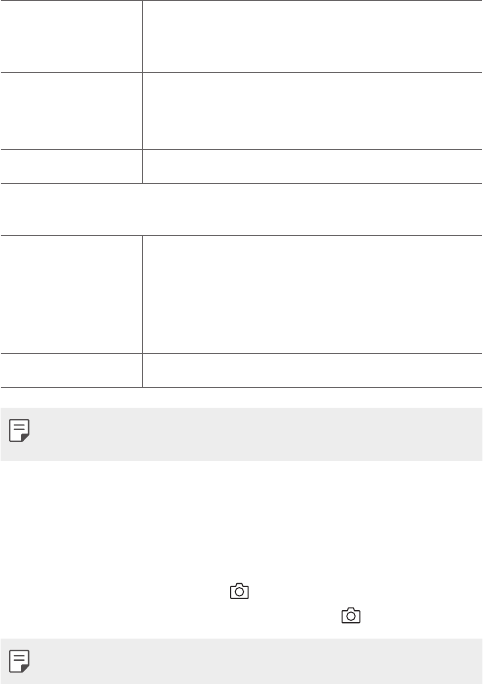
Useful Apps 67
Grid
Display guide grids to so that you can take photos
or record videos based on the horizontal and vertical
reference lines.
Storage
Select if you want to store the pictures and videos in
the Internal storage or SD card.
(Available when the memory card is inserted.)
Help Provide help information for each camera menu.
Additional options on the front camera
Selfie shot
Customize the selfie shot settings.
•Gesture shot: Take a picture using the Gesture shot
feature.
•Auto shot: Take a picture when the camera detects
a face.
Save as flipped Save as flipped images after taking selfies.
• When using the front camera, you can adjust the filter, lighting effect,
and skin tone.
Other useful features in the Camera app
Burst shot
You can take continuous shots of photos to create moving pictures.
In the AUTO mode, touch and hold .
• Continuous shots are taken at a fast speed while is held down.
• Up to thirty (30) continuous photos can be taken.
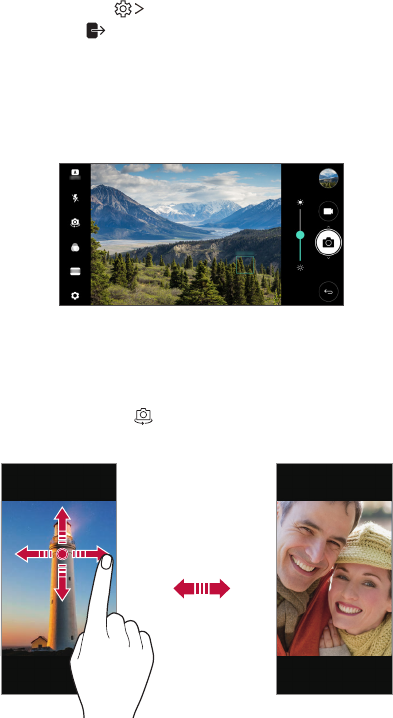
Useful Apps 68
Simple view
In the AUTO mode, tap Simple view to hide the menus on the
camera screen. Tap to display them.
AE/AF lock
You can fix the current exposure level and focus position by touching and
holding the screen in the AUTO mode. To turn off the feature, tap a blank
area on the screen.
Switching between cameras
You can switch between the front and rear cameras to suit your
environment.
On the camera screen, tap or drag the screen in any direction to switch
between the front and rear cameras.
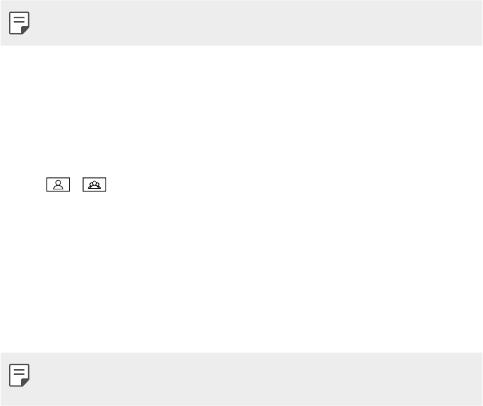
Useful Apps 69
• Use the front camera to take selfies. See
Selfie shot
for details.
Switching between the standard and wide-
angle camera
Switch between the standard and wide-angle on the front camera to take
photos or record videos to suit your preferences.
• Tap / to switch between the standard and wide-angle camera.
Zoom in or out
You can use zoom in or out on the camera screen while taking a photo or
recording a video.
• On the camera screen, pinch or spread two fingers to zoom in or out,
then use the displayed +/- slide bar.
• The zoom feature is not available when using the front camera in selfie
mode.
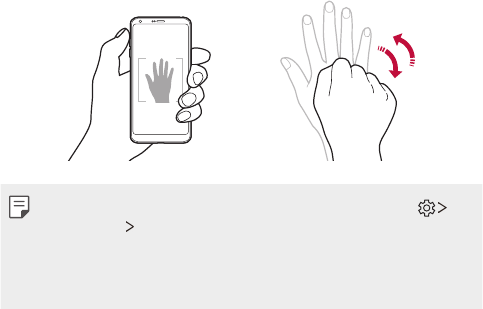
Useful Apps 70
Selfie shot
You can use the front camera to view your face on the screen and take
selfies.
Gesture shot
You can take selfies by using gestures.
Show your palm to the front camera and then clench your fist.
You can also clench your fist and then open it towards the front camera.
• In three seconds, a photo is taken.
• To use this feature, switch to the front camera mode, then tap
Selfie shot Gesture shot.
• Make sure that your palm and fist are within the reference line so that
the camera can detect them.
• This feature may not available while using some of the camera features.

Useful Apps 71
Interval shot
You can take selfies at an interval.
While using the front camera, you can show your palm to the camera,
then clench your fist twice quickly.
• Four photos are taken at about two seconds interval after a timer
delay of three seconds.
• Tap Selfie shot Gesture shot to use this feature.
Auto shot
You can use the face detection feature to take selfies easily and
conveniently. You can set the device so that, when you look at the screen,
the front camera detects your face and takes a selfie automatically.
• The white coloured guide frame appears when the front camera
detects your face. If the subject within the guide frame stops moving,
the guide frame colour turns blue, then the camera takes a photo.
• Tap Selfie shot Auto shot to enable the Auto shot feature.
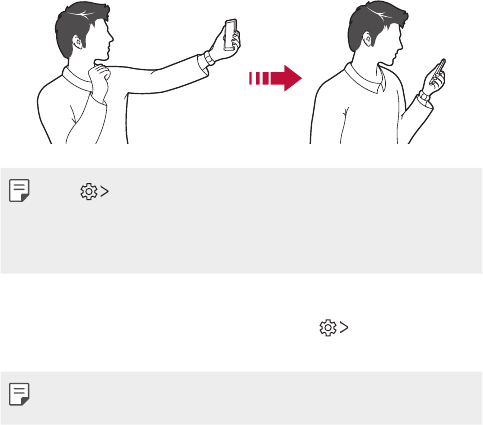
Useful Apps 72
Gesture view
After taking a selfie with the front camera, you can preview the selfie
immediately by placing the screen close to your face.
• Tap Gesture view to enable the Gesture view feature.
• Only one preview is available each time a photo is taken.
• If you rotate the device while in preview screen, the screen switches to
camera mode.
Save as flipped
Before taking a photo with the front camera, tap Save as flipped.
The image is flipped horizontally.
• When using the front camera, you can change how selfies are taken in
the camera options. See
Customizing the camera options
for details.

Useful Apps 73
Gallery
Gallery overview
You can view and manage photos and videos saved on your device.
1 Tap .
• Saved photos and videos are displayed by folder.
2 Tap a folder and select a file.
• View the selected file in full-screen mode.
• While viewing a photo, swipe left or right to view the previous or
next photo.
• While viewing a video, swipe left or right to rewind or fast-forward
the video.
• Some file formats may not be supported, depending on the installed
software.
• Some files may not be opened due to encoding.
• Files that exceed the size limit may cause an error.
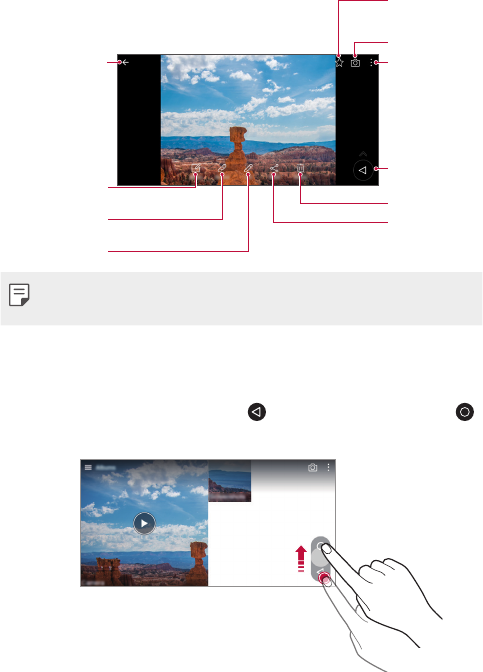
Useful Apps 74
Viewing photos
Back to the
previous screen.
Write a memo on a
photo.
View related
content.
Edit images.
Access additional
options.
Back to the
previous screen.
Delete images.
Start the camera.
Add to or remove
from your
favourites.
Share images.
• To display the menu items, gently tap the screen. To hide the menu
items, tap the screen again.
Floating button
To quickly move to the Home screen while viewing the Gallery in
landscape orientation, touch and hold , move your finger upward to ,
then release it.
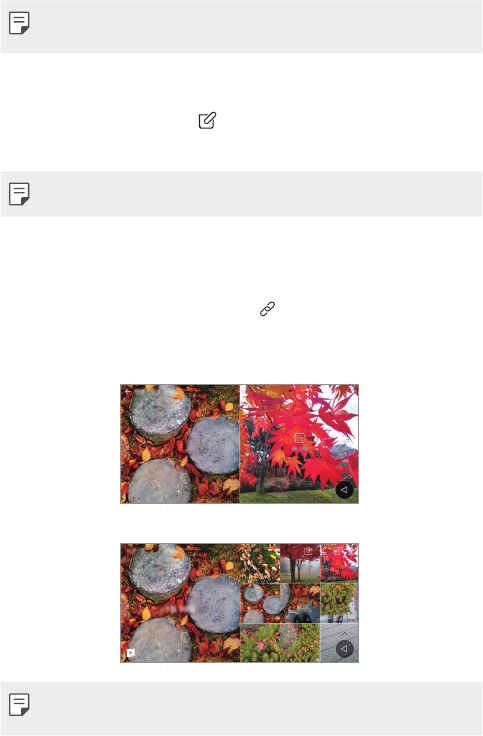
Useful Apps 75
• You can move the floating button's position by dragging it horizontally
along the bottom part of the screen.
Writing a memo on the photo
1 While viewing a photo, tap .
2 Write a memo on the photo and tap SAVE.
• Some photos may not support the photo memo feature.
Related content
You can edit and customize related content in the Gallery.
1 While viewing a picture preview, tap .
2 When the icon related with the date you took the photo appears,
touch the screen.
• You can view the photos related with the date you chose.
• Related content can be related to up to four combinations of ‘Memories,
Date, Place, Camera mode’.
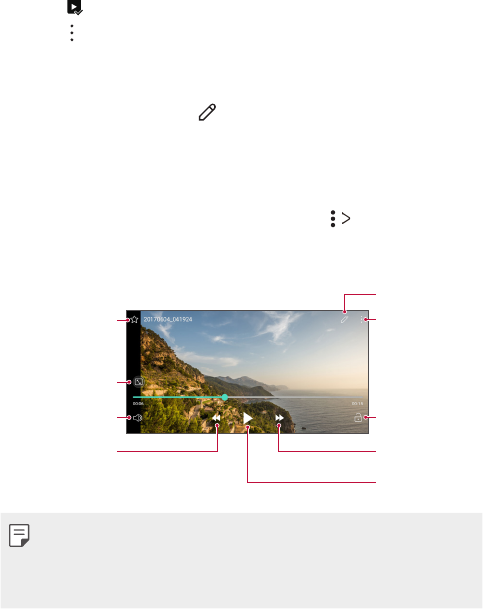
Useful Apps 76
• Tap to save the related content as a video.
• Tap to access additional options.
Editing photos
1 While viewing a photo, tap .
2 Use a variety of effects and tools to edit the photo.
3 Tap SAVE to save changes.
• The changes are overwritten to the original file.
• To save the edited photo as another file, tap Save copy.
Playing a video
Add to or remove
from your
favourites.
Choose screen
ratio.
Adjust the sound
volume.
Rewind the video.
Access additional
options.
Lock or unlock
the screen.
Edit the video.
Fast-forward the
video.
Pause or play the
video.
• To adjust the sound volume, drag the right side of the video screen up
or down.
• To adjust the screen brightness, drag the left side of the video screen
up or down.

Useful Apps 77
Editing videos
1 While viewing a video, tap .
2 Use a variety of effects and edit tools to edit the video.
Revert the edit.
Adjust the
resolution.
Launch the
KineMaster video
editor.
Adjust the video
duration.
Create a movie
using various
effects.
Automatically
create a 15 sec,
30 sec or 60 sec
video clip.
Select a section
to change the
play speed.
3 Tap SAVE to save changes.
Making a GIF
You can easily make a GIF file using previously recorded video.
At the desired starting point while watching the video, tap Create
GIF.
• The GIF file is generated for the time selected from the current time.
• For videos less than 5 seconds, GIF images are automatically generated
for the remaining time.
• The GIF making feature is provided for the user’s creative activity. If you
infringe other’s copyright or defamation laws by using the GIF making
feature, you may be liable for civil and criminal liability. Be sure to not
duplicate or transfer work of others without permission. LG Electronics
cannot accept any liability for the user’s action.

Useful Apps 78
Related files
You can relate files by photos and videos taken with the same location or
date.
1 Select the saved photos and videos and tap .
2 Select a desired folder, then tap to create a video.
Deleting files
You can delete files by using one of the following options:
• Touch and hold a file from the file list, then tap Delete.
• Tap from the file list and delete the desired files.
• Deleted files are automatically moved to Trash and they can be
restored to the Gallery within 7 days.
• On the Gallery, tap Trash. Tap to completely delete the files. In
this case, the files cannot be restored.
Sharing files
You can share files by using one of the following options:
• While viewing a photo, tap to share the file by using the method
you want.
• While viewing a video, Share to share the file by using the method
you want.
• Tap from the file list to select files and share them using the method
you want.

Useful Apps 79
Contacts
Contacts overview
You can save and manage contacts.
Tap Essentials Contacts.
Adding contacts
Adding new contacts
1 On the contact list screen, tap .
2 Enter contact details and tap SAVE.
Importing contacts
You can import contacts from another storage device.
1 On the contact list screen, tap Manage contacts Import.
2 Select the source and target locations of the contact you want to
import, and then tap OK.
3 Select the vCard file(s) and tap IMPORT.
Adding contacts to the speed dial list
1 On the contact list screen, tap Speed dial.
2 Tap Add contact from a speed dial number.
3 Select a contact.

Useful Apps 80
Searching for contacts
You can search for contacts by using one of the following options:
• On the contact list screen, enter a contact name in the search box.
• Scroll the contact list up or down.
• From the index of the contact list screen, tap the initial letter of a
contact.
Contacts list
Editing contacts
1 On the contact list screen, select a contact.
2 On the contact detail screen, tap and edit details.
3 Tap SAVE to save changes.
Deleting contacts
You can delete contacts by using one of the following options:
• On the contact list screen, touch and hold a contact you want to
delete, then tap Delete contact.
• Tap Delete on the contact list screen.
Adding favourites
You can register frequently used contacts as favourites.
1 On the contact list screen, select a contact.
2 On the contact detail screen, tap .
Creating groups
1 On the contact list screen, tap Groups New group.
2 Enter a new group name.
3 Tap Add members, select contacts, then tap ADD.
4 Tap SAVE to save the new group.

Useful Apps 81
QuickMemo+
QuickMemo+ overview
You can make creative notes by using a variety of options on this
advanced notepad feature, such as image management and screenshots,
which are not supported by the conventional notepad.
Creating a note
1 Tap QuickMemo+.
2 Tap to create a note.
• : Save a note.
• : Undo the last action.
• : Redo the last action you undid.
• : Enter a note by using the keypad.
• : Write notes by hand.
• : Erase handwritten notes.
• : Zoom in or out, rotate or erase the parts of a handwritten note.
• : Access additional.
3 Tap to save the note.
Writing notes on a photo
1 Tap QuickMemo+.
2 Tap to take a photo, then tap OK.
• The photo is automatically attached into the notepad.
3 Tap or to write notes on the photo.
• Write notes by hand on the photo.
• Enter text below the photo.
4 Tap to save the note.
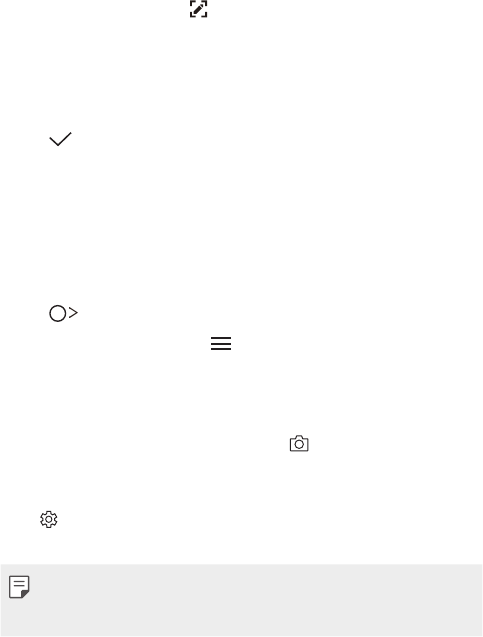
Useful Apps 82
Writing notes on a screenshot
1 While viewing the screen you want to capture, drag the status bar
downwards and then tap .
• The screenshot appears as the notepad background theme. Memo
tools appear at the top of the screen.
2 Take notes as desired.
• Write notes by hand on the photo.
3 Tap and save the notes to the location you want.
• Saved notes can be viewed in either QuickMemo+ or Gallery.
• To save notes in the same location all the time, select the Use as
default app checkbox and select an app.
Managing folders
You can view notes grouped by the type of the notes.
1 Tap QuickMemo+.
2 At the top of the screen, tap and select a menu item:
• All memos: View all notes saved in QuickMemo+.
• My memos: View notes created by QuickMemo+.
• Capture+: View notes created by Capture+.
• Photo memos: View notes created by .
• Trash: View deleted notes.
• New category: Add categories.
• : Rearrange, add or delete categories. To change the name of a
category, tap the category.
• Some folders do not appear when launching QuickMemo+ for the first
time. Disabled folders are enabled and appear when they contain at
least one related note.
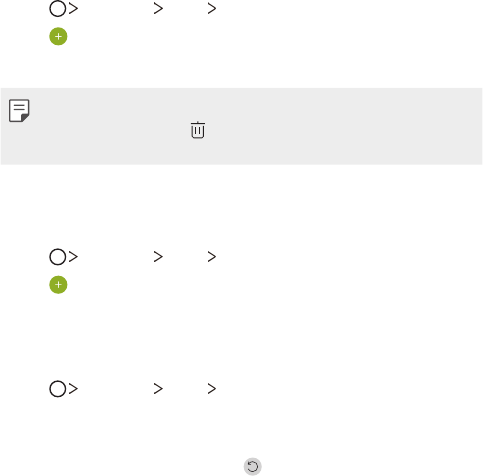
Useful Apps 83
Clock
Alarm
You can set an alarm to trigger it at a specified time.
1 Tap Essentials Clock Alarm.
2 Tap to add a new alarm.
3 Configure the alarm settings and tap SAVE.
• If you select a previously set alarm, you can edit the alarm.
• To delete an alarm, tap at the top of the screen. You can also touch
and hold the alarm.
World clock
You can view the current time in cities around the world.
1 Tap Essentials Clock World clock.
2 Tap and add a city.
Timer
You can set the timer to trigger an alarm after a specified period of time.
1 Tap Essentials Clock Timer.
2 Set the time and tap Start.
• To suspend the timer, tap Pause. To resume the timer, tap Resume.
• To reset the timer settings, tap .
3 Tap Stop to stop the timer alarm.

Useful Apps 84
Stopwatch
You can use the stopwatch to record a lap time.
1 Tap Essentials Clock Stopwatch.
2 Tap Start to initiate the stopwatch.
• To record a lap time, tap Lap.
3 Tap Pause to suspend the stopwatch.
• To resume the stopwatch, tap Resume.
• To clear all the records and newly start the stopwatch, tap Reset.
Calendar
Calendar overview
You can use the calendar to manage events and tasks.
Adding events
1 Tap Essentials Calendar.
2 Select a date and then tap .
3 Enter event details and tap SAVE.
• If you tap a date from the calendar and the date contains events, a
pop-up window appears showing a list of the events. Tap an event
from the pop-up window to view the event details.
Syncing events
Tap Calendars to sync and select a calendar to sync.
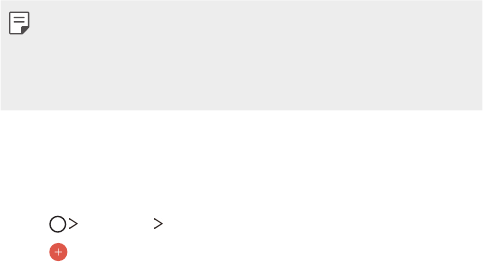
Useful Apps 85
• When your events are saved from the device to your Google account,
they are automatically synced with the Google calendar, too. Then, you
can sync other devices with the Google calendar in order to make those
devices have the same events that your device has and to manage your
events on those devices.
Tasks
You can register tasks to your device to easily manage schedules.
1 Tap Essentials Tasks.
2 Tap to add a task.
3 Enter task details and then tap SAVE.
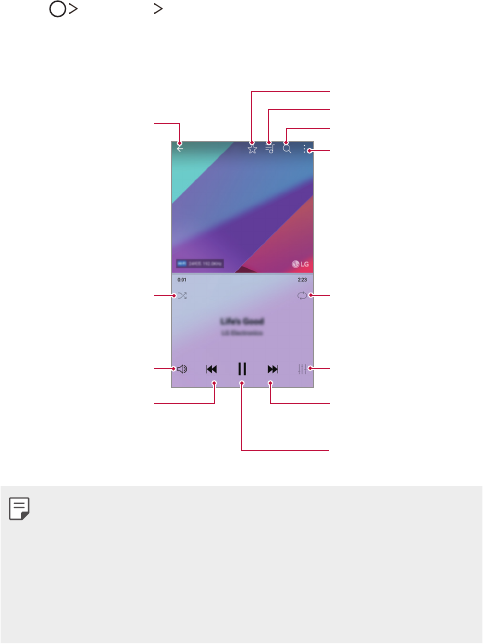
Useful Apps 86
Music
You can play and manage songs or music albums.
1 Tap Essentials Music.
2 Select a category.
3 Select a music file.
Switch to the playlist.
Search for music files.
Play in random order. Select a repeat mode.
Tap to play the next file /
Touch and hold to fast
forward.
Tap to play from the
beginning of the
current file /
Double-tap to play the
previous file /
Touch and hold to rewind.
Adjust the sound volume. Set sound effects.
Back to the previous
screen.
Add or delete favourites.
Pause or play.
Access additional options.
• Some file formats may not be supported, depending on the installed
software.
• Files that exceed the size limit may cause an error.
• Music files may be protected by international copyright owners or
copyright laws. You may have to obtain legal permission before copying
a music file. To download or copy a music file, first check the copyright
law for the relevant country.
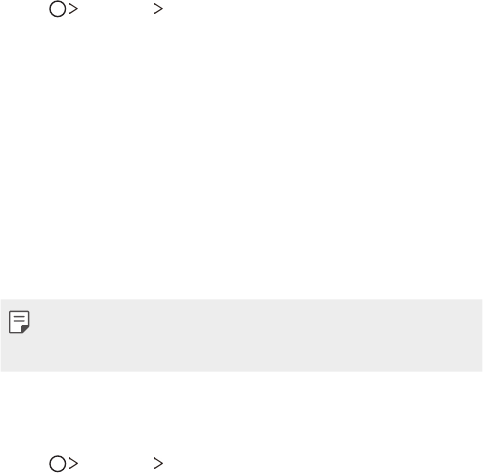
Useful Apps 87
Calculator
You can use two types of calculators: the simple calculator and the
scientific calculator.
1 Tap Essentials Calculator.
2 Use the keypad to make a calculation.
• To use scientific calculator, drag the green coloured slide bar located
in the right side of the screen to the left.
• To restart a calculation, touch and hold the DEL button.
E-mail
E-mail overview
You can register an email account to your device and then you can check
and send emails from your device.
• If you use mobile data, you may be charged for data usage depending
on your pricing plan. Consult with your service provider for more
information.
Registering email accounts
When you use the email app for the first time, register your email account.
1 Tap Essentials E-mail.
2 Select an email service provider.
3 Enter your email address and password and then tap NEXT to register
your account.
• To manually register an email account tap MANUAL SETUP.

Useful Apps 88
Managing email accounts
To view or edit your email account settings, tap Settings.
• To add an account, tap Add account.
• To delete an account, tap Remove account.
Opening another email account
If several email accounts are registered and you want to view another
account, tap and select another one from the account list.
Checking email
1 Tap and select a mail box.
2 Select an email from the email list.
• The email message appears.
Sending email
1 Tap .
2 Enter the recipient’s email address.
3 Enter a subject and message.
• To attach files, tap .
• To access optional menu items, tap .
4 Tap to send the email.
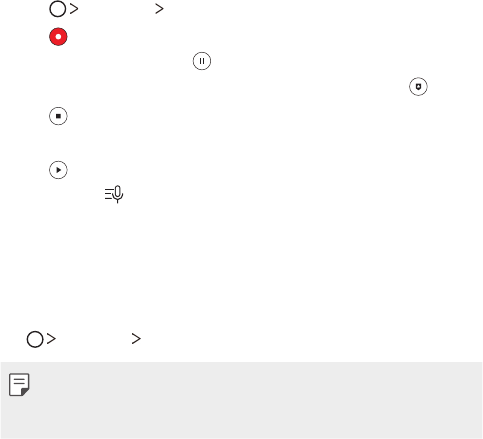
Useful Apps 89
Audio Recorder
You can record and save your voice or others’ voices from important
events. Recorded voice files can be played back or shared.
1 Tap Essentials Audio Recorder.
2 Tap .
• To pause recording, tap .
• To insert a bookmark while making a voice recording, tap .
3 Tap to end recording.
• The file is saved automatically and the pre-listen screen appears.
4 Tap to play the recorded voice.
• If you tap , recorded voice files appear. You can play a recorded
voice file from the list.
NextRadio
You can listen to FM radio.
Tap Essentials NextRadio.
• To use this app, first connect earphones to the device. The earphones
function as the radio antenna.
• This function may not be supported depending on the area.
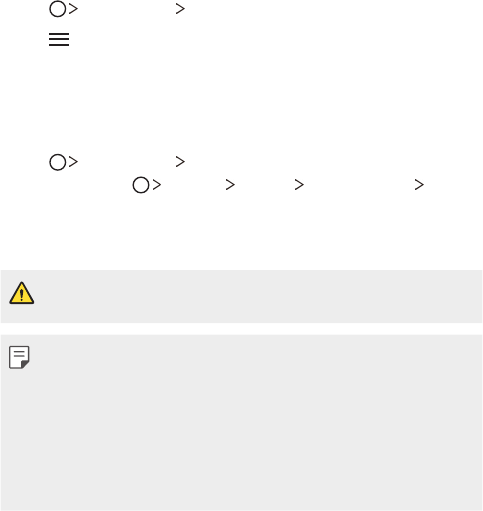
Useful Apps 90
File Manager
You can view and manage files saved on your device or cloud.
1 Tap Management File Manager.
2 Tap and select the desired storage location.
LG Mobile Switch
You can back up, restore and move the data saved on your device.
1 Tap Management LG Mobile Switch.
You can also tap Settings General Backup & reset LG
Mobile Switch.
2 Follow the on-screen instructions to select a desired method for
transfer.
• Resetting your device may delete backup files saved in internal storage.
Make sure to copy and store the important backup files to your PC.
• Data in a Google account will not be backed up. When you synchronize
your Google account, Google apps, Google contacts, Google calendar,
Google memo app data and apps downloaded from Play store are
stored on the Drive app automatically.
• Backup files are saved with the file extension *.lbf under the LG Backup
folder on the memory card or internal storage.
• Fully charge the battery before backing up or restoring data to avoid
unintentional powering off during the process.
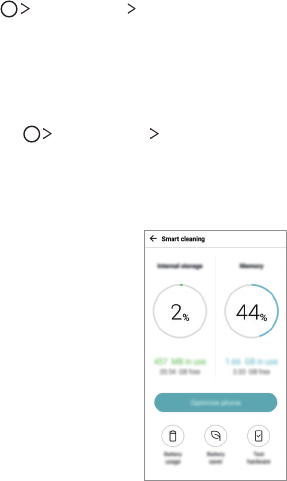
Useful Apps 91
Downloads
You can view, delete or share files downloaded via the Internet or apps.
Tap Management Downloads.
Smart cleaning
You can delete temporary files or apps that are no longer used.
1 Tap Management Smart cleaning.
2 On the Smart cleaning screen, you can access Optimize phone,
Battery usage, Battery saver, and Test hardware by tapping the
desired menu.
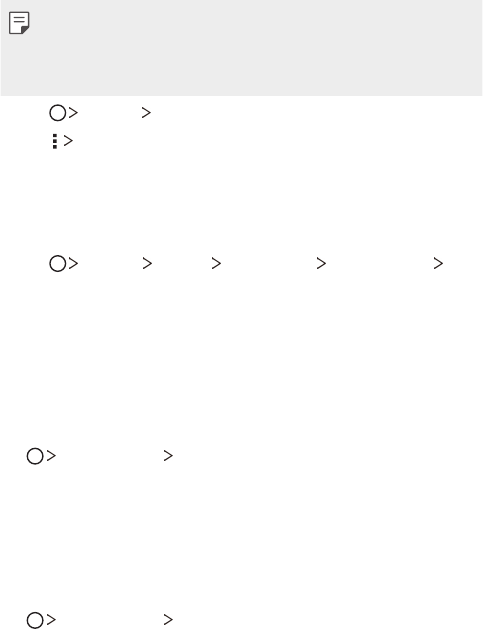
Useful Apps 92
LG SmartWorld
You can download a variety of games, audio content, apps and fonts
provided by LG Electronics. Customize your device to suit your preferences
by using Home themes and fonts.
• If you use mobile data, you may be charged for data usage depending
on your pricing plan.
• This feature may not be supported depending on the area or service
provider.
1 Tap Services SmartWorld.
2 Tap Sign in, then sign in.
3 Select and download content items.
Downloading SmartWorld app
If SmartWorld app is not installed, follow these steps to download it.
1 Tap Settings General About phone Update Centre App
Updates.
2 From the list, tap the Download button next to SmartWorld.
Facebook
You can use a social networking service to update, view and share posts,
photos and videos with your online contacts.
Tap Recommended Facebook.
Instagram
Use a social networking service to capture and share your photos and
videos. You can also apply filter effects to make your photos and videos
more creative and interesting.
Tap Recommended Instagram.

Useful Apps 93
Chrome
Sign in to Chrome and import opened tabs, bookmarks and address bar
data from a computer to your device.
Google apps
You can use Google apps by setting a Google account. The Google account
registration window appears automatically when you use a Google app for
the first time. If you do not have a Google account, create one from your
device. For details on how to use an app, see the Help in the app.
• Some apps may not work depending on the area or service provider.
Docs
Create documents or edit documents created online or from another
device. Share and edit documents together with others.
Drive
Upload, save, open, share and organize files from your device. Files
accessible from apps can be accessed from anywhere, including online and
offline environments.
Duo
Make a video call with your family, friends and anyone else who uses the app.
Gmail
Register your Google email account to your device to check or send email.
Google
Use the Google to search for web pages, images, news and more by
entering or speaking keywords.

Useful Apps 94
Maps
Find your location or the location of a place on the map. View geographical
information.
Photos
View or share photos or albums saved on your device.
Play Movies & TV
Use your Google account to rent or purchase movies. Purchase content
and play it anywhere.
Play Music
Purchase music files from the Play Store. Play music files saved on your
device.
Sheets
Create spreadsheets or edit spreadsheets created online or from another
device. Share and edit spreadsheets together with others.
Slides
Create presentation material or edit presentation material created online
or from another device. Share and edit presentation material together
with others.
YouTube
Search and play videos. Upload videos on YouTube to share them with
people around the world.
Google Assistant
Your device has the Google Assistant built in. Ask it questions. Tell it to do
things. It’s your own personal Google. Touch and hold the and then you
will see “Hi, how can I help?”, after which you can say your voice command.
• The Google Assistant is not available in all languages.

Settings
04
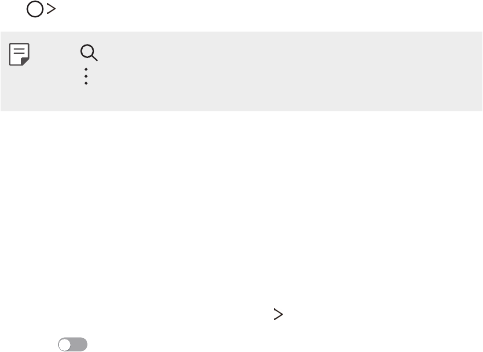
Settings 96
Settings
You can customize the device settings in accordance with your
preferences.
Tap Settings.
• Tap and enter a keyword in the search box to access a setting item.
• Tap to change the view mode. This user guide assumes that you are
using the Tab view.
Networks
Wi-Fi
You can connect to nearby devices over a Wi-Fi network.
Connecting to a Wi-Fi network
1 On the settings screen, tap Networks Wi-Fi.
2 Drag to activate it.
• Available Wi-Fi networks appear automatically.
3 Select a network.
• You may need to enter the network's Wi-Fi password.
• The device skips this process for previously accessed Wi-Fi
networks. If you do not want to automatically connect to a certain
Wi-Fi network, touch and hold the network and then tap Forget
network.
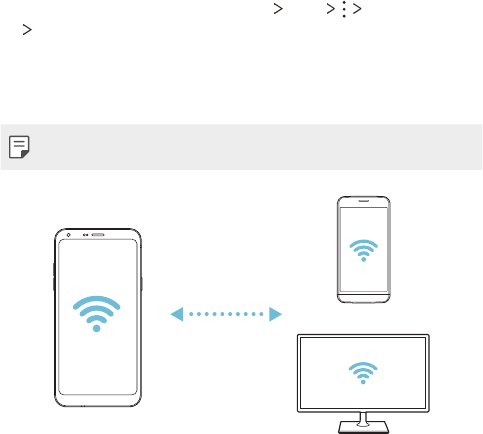
Settings 97
Wi-Fi Direct
You can connect your device to other devices that support Wi-Fi Direct to
share data directly with them. You do not need an access point. You can
connect with more than two devices by using Wi-Fi Direct.
1 On the settings screen, tap Networks Wi-Fi Advanced Wi-Fi
Wi-Fi Direct.
• Nearby devices that support Wi-Fi Direct automatically appear.
2 Select a device.
• Connection occurs when the device accepts the connection request.
• The battery may drain faster when using Wi-Fi Direct.
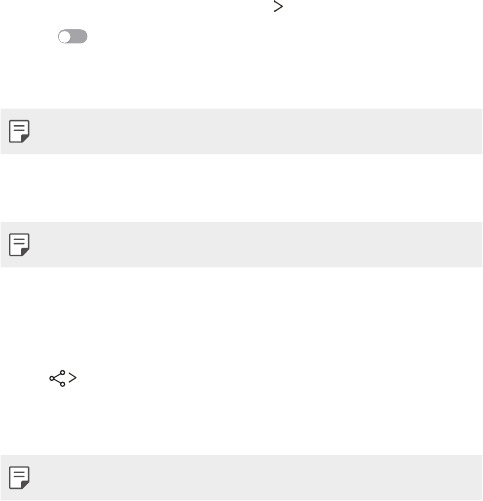
Settings 98
Bluetooth
You can connect your device to nearby devices that support Bluetooth to
exchange data with them. Connect your device to a Bluetooth headset
and a keyboard. This makes it easier to control the device.
Pairing with another device
1 On the settings screen, tap Networks Bluetooth.
2 Drag to activate it.
• Available devices appear automatically.
• To refresh the device list, tap SEARCH.
• Only devices set as visible are displayed on the list.
3 Select a device from the list.
4 Follow the on-screen instructions to perform authentication.
• This step is skipped for previously accessed devices.
Sending data via Bluetooth
1 Select a file.
• You can send multimedia files or contacts.
2 Tap Bluetooth.
3 Select a target device for the file.
• The file is sent as soon as the target device accepts it.
• File sharing processes may differ, depending on the file.
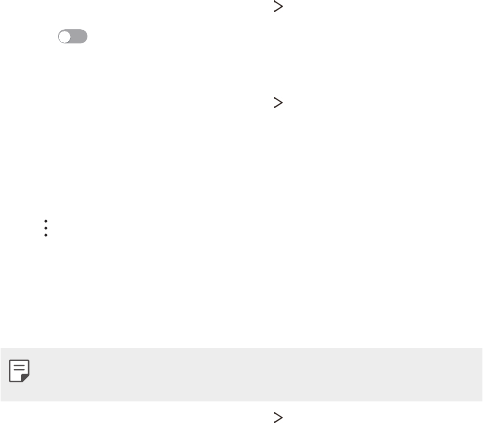
Settings 99
Mobile data
You can turn on or off mobile data. You can also manage mobile data
usage.
Turning on mobile data
1 On the settings screen, tap Networks Mobile data.
2 Drag to activate it.
Customizing mobile data settings
1 On the settings screen, tap Networks Mobile data.
2 Customize the following settings:
• Mobile data: Set to use data connections on mobile networks.
• Limit mobile data usage: Set a limit for mobile data usage to block
mobile data if the limit is reached.
• : Customize mobile data settings.
Call
You can customize call settings, such as voice call and international call
options.
• Some features may not be supported depending on the area or service
provider.
1 On the settings screen, tap Networks Call.
2 Customize the desired settings.
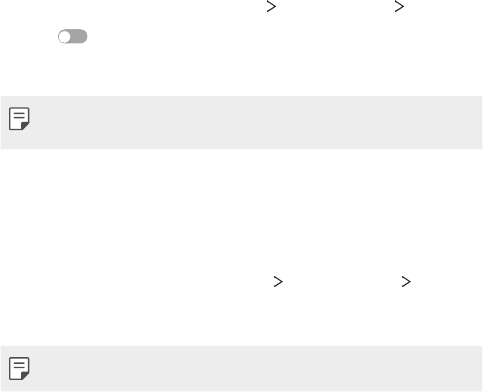
Settings 100
Share & connect
NFC
You can use the device as a transportation card or credit card. You can also
share data with other devices.
1 On the setting screen, tap Networks Share & connect NFC.
2 Drag to activate it.
• Touch your device with other device that supports NFC to allow
sharing data.
• NFC antenna may be located differently depending on the device type.
See
Parts overview
for details about the NFC antenna area.
Android Beam
You can share files by touching the back of the device to other device. You
can also share files including music, videos or contacts and open a web
page or launch an app from the other device.
1 On the settings screen, tap Networks Share & connect Android
Beam.
2 Touch the back of the device with another device.
• NFC antenna may be located differently depending on the device type.
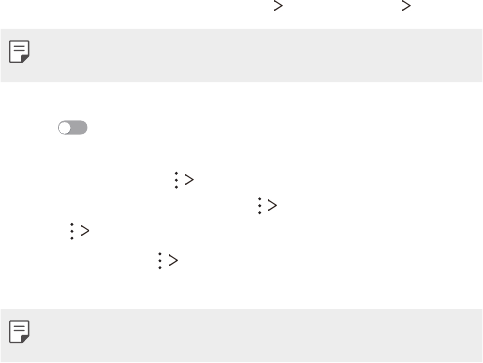
Settings 101
Printing
You can connect your device to a wireless printer and print photos or
documents saved on the device.
1 On the settings screen, tap Networks Share & connect Printing.
• If the desired printer is not in the list, install the printer driver from the
app store.
2 Select print service.
3 Drag to activate it.
4 Select a printer from the printer list screen.
• To add a printer, tap Add printer.
• To search for a printer name, tap Search.
• Tap Settings from the printer list screen.
5 Select a file and tap Print.
• The document prints.
• If you do not have a Google account, tap ADD ACCOUNT to create an
account.
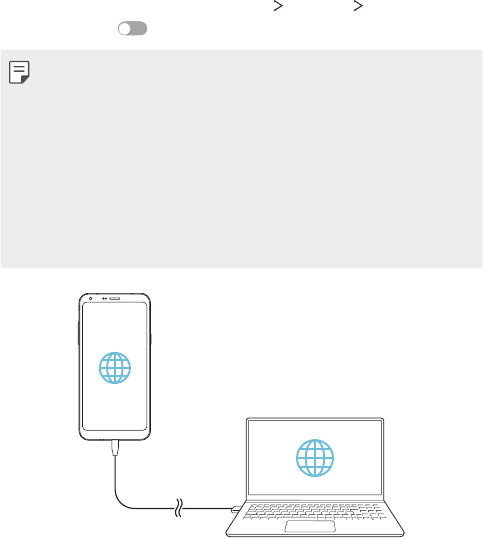
Settings 102
Tethering
USB tethering
You can connect the device to another device via USB and share mobile
data.
1 Connect your device and other devices via USB cable.
2 On the settings screen, tap Networks Tethering USB tethering
and then drag to activate it.
• This option uses mobile data and may incur data usage fees, depending
on your pricing plan. Consult with your service provider for more
information.
• When connecting to a computer, download the USB driver from
www.lg.com
and install it on the computer.
• You cannot send or receive files between your device and a computer
while USB tethering is turned on. Turn off USB tethering to send or
receive files.
• Operating systems that support tethering are Window XP or higher, or
Linux.
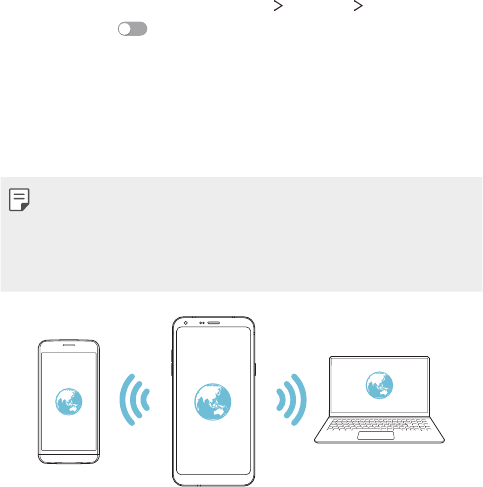
Settings 103
Wi-Fi hotspot
You can set the device as a wireless router so that other devices can
connect to the Internet by using your device's mobile data.
1 On the settings screen, tap Networks Tethering Wi-Fi hotspot
and then drag to activate it.
2 Tap Set up Wi-Fi hotspot and enter the Wi-Fi name (SSID) and
password.
3 Turn on Wi-Fi on the other device, and select the name of the device
network on the Wi-Fi list.
4 Enter the network password.
• This option uses mobile data and may incur data usage fees, depending
on your pricing plan. Consult with your service provider for more
information.
• More information is available at this web site:
http://www.android.com/tether#wifi
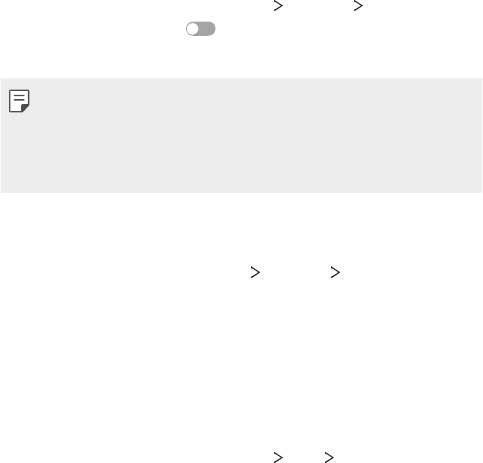
Settings 104
Bluetooth tethering
A Bluetooth-connected device can connect to the Internet by using your
device's mobile data.
1 On the settings screen, tap Networks Tethering Bluetooth
tethering and then drag to activate it.
2 Turn on Bluetooth on both devices and pair them.
• This option uses mobile data and may incur data usage fees, depending
on your pricing plan. Consult with your service provider for more
information.
• More information is available at this web site:
http://www.android.com/tether#Bluetooth_tethering
Help
You can view help on using tethering and hotspots.
On the settings screen, tap Networks Tethering Help.
More
Airplane mode
You can turn off the call and mobile data functions. When this mode is
on, functions that do not involve data, such as games and music playback,
remain available.
1 On the settings screen, tap Networks More Airplane mode.
2 Tap TURN ON in the confirmation screen.

Settings 105
Mobile networks
You can customize the following the mobile networks settings.
1 On the settings screen, tap Networks More Mobile networks.
2 Customize the following settings:
• Mobile data: Turn mobile data on or off.
• VoLTE: Turn VoLTE on or off.
• Data roaming: Turn data roaming on or off.
• Network mode: Select a network type.
• Access Point Names: View or change the access point for using
mobile data services. To change the access point, select a choice
from the access point list.
• Network operators: Search for network operators and connect
automatically to a network.
VPN
You can connect to a safe virtual network, such as an intranet. You can
also manage connected virtual private networks.
Adding VPN
1 On the settings screen, tap Networks More VPN.
2 Tap Basic VPN or LG VPN.
3 Tap Add Basic VPN or Add LG VPN.
• This feature is available only when the screen lock is activated. If the
screen lock is deactivated, a notification screen appears. Tap SETTINGS
from the notification screen to activate the screen lock. See
Setting a
screen lock settings
for details.
4 Enter VPN details and tap SAVE.
Settings 106
Configuring VPN settings
1 Tap a VPN from the VPNS list.
2 Enter the VPN user account details and tap CONNECT.
• To save the account details, select the Save account information
checkbox.
Sound & notification
You can customize sound, vibrate and notification settings.
On the settings screen, tap Sound & notification and customize the
following settings:
• Sound profile: Change the sound mode to Sound or Vibrate only.
• Volume: Adjust the sound volume for various items.
• Ringtone: Select a ringtone for incoming calls. Add or delete ringtones.
• Ringtone ID: Create a ringtone for an incoming call from a particular
contact.
• Sound with vibration: Set the device to vibrate and play a ringtone
simultaneously.
• Vibration type: You can select the type of vibration when receiving
calls.
• Do not disturb: Set the time, range and app type to receive
notification messages. Receive notification messages only on particular
days of the week.
• Lock screen: Display or hide a notification message on the lock screen.
You can also hide private information.
• Apps: Select the apps that can show their notification messages on
the screen and set the priorities of those apps in regard to notification
messages.

Settings 107
• More Notification sound: Select a notification ringtone. Set music
saved on the device as a notification ringtone.
• More Vibrate on tap: Set the device to vibrate when you tap certain
items on the screen.
• More Sound effects: Select a sound effect to play when you tap the
dialpad or keyboard, select an option, or lock or unlock the screen.
Display
You can customize detailed settings for each screen type.
On the settings screen, tap Display and customize the following settings:
• Home screen: Customize settings for the Home screen. See
Home
screen settings
for details.
• Lock screen: Customize lock screen settings. See
Lock screen settings
for details.
• Theme: Select a screen theme for your device.
• Home touch buttons: Rearrange Home touch buttons or change
their background colours. You can also choose to hide the Home touch
buttons on the screen.
• Font type: Change the font face.
• Font size: Change the font size.
• Bold text: Bold the text on the screen.
• App scaling: Adjust the screen size of apps.
• Display size: Set the items on the screen to a size that is easy for you
to see. Some items may change position.
• Comfort view: Set the device to reduce amount of blue light on screen
to reduce eye strain.
• Brightness: Use the slide bar to change the device's screen brightness.
To automatically adjust screen brightness according to ambient light
intensity, tap the Auto switch.

Settings 108
• Auto: Set the device so that the screen brightness is automatically
adjusted in accordance with the ambient light intensity.
• Auto-rotate screen: Automatically rotate the screen according to the
device's orientation.
• Screen timeout: Automatically turn off the screen when the device is
left idle for a specified period of time.
• More KnockON: Turn the screen on or off by tapping the screen
twice.
• More Screen saver: Display a screen saver when the device is
connected to the holder or charger. Select a screen saver type to
display.
General
Language & keyboard
You can customize language and keyboard settings for your device.
1 On the settings screen, tap General Language & keyboard.
2 Customize the following settings:
• Language: Select a language to apply for the device.
• Current keyboard: View the keyboard currently in use. Select a
keyboard to use when entering text.
• LG Keyboard: Customize the LG keyboard settings.
• Google voice typing: Configure the options for text dictation by
Google.
• Text-to-speech output: Configure the settings for text-to-speech
output.
• Pointer speed: Adjust the pointer speed of a mouse or trackpad.
• Reverse buttons: Reverse the right mouse button to perform
primary direct-manipulation actions.

Settings 109
Location
You can customize how your location information is used by particular
apps.
1 On the settings screen, tap General Location.
2 Customize the following settings:
• Mode: Select a method to provide your location information.
• RECENT LOCATION REQUEST: View apps that recently requested
location information.
• Low power location estimation: Estimate the device location by
using low power consumption.
• Google Location History: Configure the Google location history
settings.
• Google Location Sharing: Allows you to share your real-time
location with your contacts.
Accounts & sync
You can add or manage accounts, including a Google account. You can also
sync particular apps or user information automatically.
1 On the settings screen, tap General Accounts & sync.
2 Customize the following settings:
• Auto-sync data: Sync all the registered accounts automatically.
• ACCOUNTS: View a list of registered accounts. To view or change
details of an account, tap the account.
• ADD ACCOUNT: Add accounts.

Settings 110
Accessibility
You can manage accessibility plug-ins installed on your device.
1 On the settings screen, tap General Accessibility.
2 Customize the following settings:
• Vision TalkBack: Set the device to notify screen status or actions
via voice.
• Vision Voice notifications: Set the device to read the caller
information or message content via voice.
• Vision Font size: Change the font size.
• Vision Bold text: Bold the text on the screen.
• Vision Display size: Set the items on the screen to a size that is
easy for you to see. Some items may change position.
• Vision Touch zoom: Zoom in or out by tapping the screen three
times.
• Vision Window zoom: Zoom in or out within a window and invert
the colour.
• Vision Large mouse pointer: Magnify the mouse pointer.
• Vision High contrast screen: Turn the background colour into
black for a high contrast screen.
• Vision Screen colour inversion: Increase the display colour
contrast for people with low vision.
• Vision Screen colour adjustment: Adjust the display colour.
• Vision Grayscale: Switch the screen to grayscale mode.
• Vision End call with the Power key: End a call by pressing the
Power/Lock key.
• Hearing Captions: Turn on the subtitle service when playing
videos for the hearing impaired.
• Hearing Flash alerts: Set the device to notify you with a blinking
light for incoming calls, messages and alarms.
• Hearing Mute all sounds: Mute all sounds and lower volume on
the receiver.

Settings 111
• Hearing Audio channel: Select the audio type.
• Hearing Sound balance: Adjust the audio output balance. Use the
slide bar to change the balance.
• Motor & cognition Touch assistant: Turn on the touch board to
make buttons and gestures easier to use.
• Motor & cognition Touch input: Enter text by touching and
holding the screen or modify it by simply touching the screen.
• Motor & cognition Physical keyboard: Customize the keyboard
settings.
• Motor & cognition Auto mouse click: Automatically click where
the pointer stops.
• Motor & cognition Touch and hold for calls: Answer or decline
calls by touching and holding the call button instead of dragging it.
• Motor & cognition Screen timeout: Turn off the screen
automatically when the device is left idle for a specified period of
time.
• Motor & cognition Touch control areas: Limit the touch area
so that only a particular portion of the screen can be controlled by
touch input.
• Accessibility features shortcut: Quickly access a frequently used
function by tapping three times.
• Auto-rotate screen: Automatically change the screen orientation
according to the physical position of the device.
• Select to Speak: Tap items to hear spoken feedback.
• Switch Access: Create key combinations to control your device.

Settings 112
Shortcut keys
You can use the volume keys to directly launch apps when the screen is
turned off or locked.
1 On the settings screen, tap General Shortcut keys.
2 Drag to activate it.
• Press the Volume Down (-) key twice to launch the Camera app
when the screen is locked or turned off. Press the Volume Up (+)
key twice to launch Capture+.
Google services
You can use Google settings to manage your Google apps and account
settings.
On the settings screen, tap General Google services.
Security
1 On the settings screen, tap General Security.
2 Customize the following settings:
• Content lock: Set the method to lock files in the QuickMemo+.
• Encrypt SD card: Encrypt the memory card to prevent use on
another device. See
Memory card encryption
for details.
• Secure start-up: Protect your device with a lock when it powers on.
See
Secure start-up settings
for details.
• Set up SIM card lock: Lock or unlock the SIM card, or change the
password (PIN).
• Make passwords visible: Display a password as you enter it.
• Phone administrators: Allow privileges to restrict the control or
use of the device to particular apps.
• Unknown sources: Allow the installation of apps from non-Play
Store apps.

Settings 113
• Credential protection: View the type of the storage where the
security certificate will be saved.
• Certificate management: Manage the security certificate saved on
the device.
• Trust agents: View and use trust agents installed on the device.
• Screen pin: Fix the app screen so that only the currently active app
can be used.
• Usage access: View details on usage of apps on the device.
Date & time
You can customize date and time settings for your device.
1 On the settings screen, tap General Date & time.
2 Customize the desired settings.
Storage
You can view and manage internal storage on the device or storage space
of the memory card.
1 On the settings screen, tap General Storage.
2 Customize the following settings:
• DEVICE STORAGE: View the total storage space and free space
in the device’s internal storage. View a list of apps in use and the
storage capacity for each app.
• PORTABLE STORAGE: View the total storage space and free space
in the memory card. This option appears only when a memory card
is inserted. To unmount the memory card, tap .

Settings 114
Battery & power saving
You can view the current battery information or turn on power-saving
mode.
1 On the settings screen, tap General Battery & power saving.
2 Customize the following settings:
• Battery usage: View the battery usage details. To view more details,
select a specific item.
• Battery percentage on status bar: Display the remaining battery
level as a percentage on the status bar.
• Battery saver: Reduce battery consumption by cutting down some
device settings, such as the display brightness, speed and vibration
intensity. The status bar displays when power-saving mode is on.
• Game battery saver: Adjust the video quality to reduce battery
consumption when playing games.
Memory
You can view the average amount of memory usage over a certain period
of time and the memory occupied by an app.
1 On the settings screen, tap General Memory.
2 Tap to set a time slot to retrieve data.
Smart cleaning
You can clean up temporary files or apps that are no longer used to free
up storage space.
1 On the settings screen, tap General Smart cleaning.
2 Select a category, then select an item to delete.
3 Tap DELETE DELETE to delete the selected item.

Settings 115
Apps
You can view a list of installed apps. Stop apps from running or delete
apps, if necessary.
1 On the settings screen, tap General Apps.
2 Select an app and perform actions.
Tap & pay
You can make payments with your device instead of a credit card. This
menu is available when NFC is on.
On the settings screen, tap General Tap & pay.
Backup & reset
You can back up data saved on your device to another device or account.
Reset the device, if necessary.
1 On the settings screen, tap General Backup & reset.
2 Customize the following settings:
• LG Mobile Switch: Back up or restore the blocked sender list,
messages, images, home screens and other data saved on the
device. See
LG Mobile Switch
for details.
• Backup & restore: Back up your device data or restore data to your
device from a backup.
• Back up my data: Back up your app data, Wi-Fi password and other
settings to the Google server.
• Backup account: View the current backup account in use.
• Google account: Back up to Google Drive.
• Automatic restore: Automatically restore backup settings and data
when reinstalling an app.
• Network settings reset: Reset Wi-Fi, Bluetooth and other network
settings.
• Factory data reset: Reset all settings for the device and delete
data.
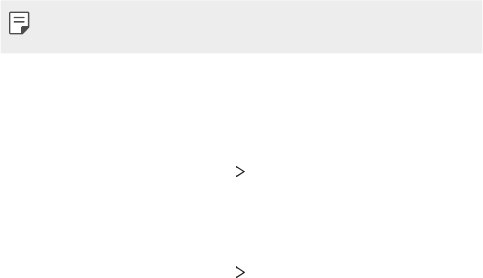
Settings 116
• Resetting your device deletes all data on it. Enter your device name,
Google account and other initial information again.
About phone
You can view information about your device, such as the name, status,
software details and legal information.
On the settings screen, tap General About phone and view information.
Regulatory & Safety
You can view regulatory marks and related information on your device.
On the settings screen, tap General Regulatory & Safety.

Appendix
05
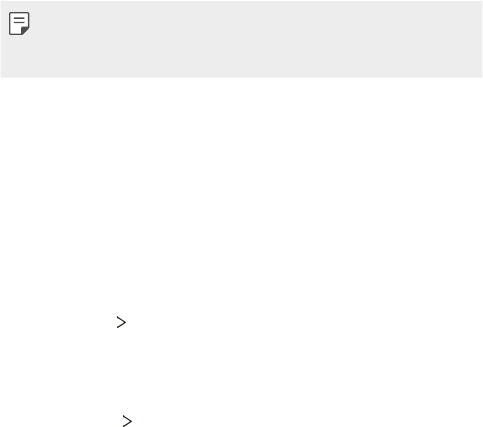
Appendix 118
LG Bridge
LG Bridge overview
LG Bridge is an app that helps you manage the photos, music, videos
and documents saved on your LG smartphone from your computer
conveniently. You can back up contacts, photos and more to the computer
or update the device software.
• The supported features may vary depending on the device.
• LG USB driver is a necessary program to connect your LG smartphone
with the computer and is installed when you install LG Bridge.
LG Bridge functions
• Back up data from the device to a computer or restore data from a
computer to the device via USB cable connection.
• Update the device software from a computer via USB cable connection.
Installing LG Bridge on a computer
1 Go to
www.lge.com
from your computer.
2 Select your region.
3 Click Support Software & Firmware.
4 Enter the name of your device.
OR
Select by the Product Category.
5 Go to PC Sync LG Bridge to download the setup file.
• Go to Details to view the minimum requirements for installing LG
Bridge.

Appendix 119
Phone software update
LG Mobile phone software update from the
Internet
For more information about using this function, please visit
http://www.lg.com/common/index.jsp
, select your country and language.
This feature allows you to conveniently update the firmware on your
phone to a newer version from the Internet without needing to visit a
service centre. This feature will only be available if and when LG makes a
newer firmware version available for your device.
Because the mobile phone firmware update requires the user’s full
attention for the duration of the update process, please make sure
you check all instructions and notes that appear at each step before
proceeding. Please note that removing the USB cable during the upgrade
may seriously damage your mobile phone.
• LG reserves the right to make firmware updates available only for
selected models at its own discretion and does not guarantee the
availability of the newer version of the firmware for all handset models.

Appendix 120
LG Mobile Phone software update via Over-
the-Air (OTA)
This feature allows you to conveniently update your phone’s software to
a newer version via OTA, without connecting a USB cable. This feature will
only be available if and when LG makes a newer firmware version available
for your device.
To perform the phone software update, Settings General About
phone Update Centre Software Update Check now for update.
• Your personal data from internal phone storage—including information
about your Google account and any other accounts, your system/
application data and settings, any downloaded applications and your
DRM license—might be lost in the process of updating your phone’s
software. Therefore, LG recommends that you backup your personal
data before updating your phone’s software. LG does not take
responsibility for any loss of personal data.
• This feature depends on the area or service provider.

Appendix 121
Anti-Theft Guide
Set up your device to prevent other people from using it if it's been reset
to factory settings without your permission. For example, if your device is
lost, stolen, or wiped, only someone with your Google account or screen
lock information can use the device.
All you need to make sure your device is protected is:
• Set a screen lock: If your device is lost or stolen but you have a screen
lock set, the device can't be erased using the Settings menu unless
your screen is unlocked.
• Add your Google account on your device: If your device is wiped but
you have your Google account on it, the device can't finish the setup
process until your Google account information is entered again.
After your device is protected, you'll need to either unlock your screen or
enter your Google account password if you need to do a factory reset.
This ensures that you or someone you trust is doing the reset.
• Do not forget your Google account and password you had added to
your device prior to performing a factory reset. If you can't provide the
account information during the setup process, you won't be able to use
the device at all after performing the factory reset.

Appendix 122
Open Source Software Notice
Information
To obtain the source code under GPL, LGPL, MPL, and other open
source licenses, that is contained in this product, please visit
http://opensource.lge.com
.
In addition to the source code, all referred license terms, warranty
disclaimers and copyright notices are available for download.
LG Electronics will also provide open source code to you on CD-ROM
for a charge covering the cost of performing such distribution (such
as the cost of media, shipping, and handling) upon email request to
opensource@lge.com
. This offer is valid for three (3) years from the date
on which you purchased the product.
Regulatory information(FCC/IC
ID number, etc.)
For regulatory details, go to Settings General Regulatory & Safety.
Trademarks
• Copyright ©2017 LG Electronics Inc. All rights reserved. LG and the LG
logo are registered trademarks of LG Group and its related entities.
• Google™, Google Maps™, Gmail™, YouTube™, Duo™ and Google Play™
store are trademarks of Google, Inc.
• Bluetooth
®
is a registered trademark of Bluetooth SIG, Inc. worldwide.
• Wi-Fi
®
and the Wi-Fi logo are registered trademarks of the Wi-Fi
Alliance.
• All other trademarks and copyrights are the property of their
respective owners.
Appendix 123
More information
Tempered glass parts
Tempered glass parts of this device are not permanent and they may wear
out over time.
• If you drop your device on a hard surface or subject it to severe impact,
the tempered glass may be damaged.
If this happens, stop using your device immediately and contact an LG
Customer Service Centre.
• You can purchase protective cases to protect your device from damage
on the market.
Note that these protective cases are not covered under the warranty
service provided by LG Electronics and safety is not guaranteed.
Aspect ratio
This device uses a 18:9 aspect ratio.
• Some downloaded apps may not support the 18:9 aspect ratio.
• In this case, select the most optimal screen ratio for the app or consult
the app provider for more information.
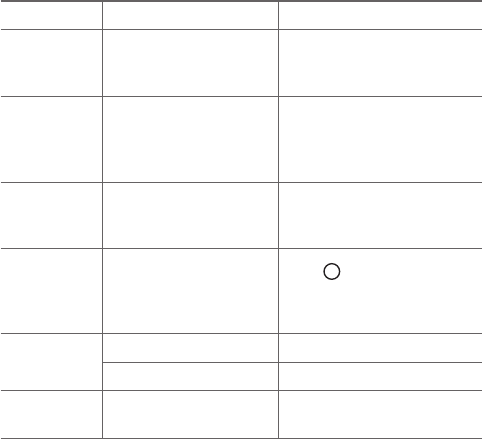
Appendix 124
FAQ
This chapter lists some problems you might encounter when using your
phone. Some problems require you to call your service provider, but most
are easy to fix yourself.
Message Possible causes Possible corrective measures
SIM card error
There is no SIM card in
the phone or it is inserted
incorrectly.
Make sure the SIM card is
correctly inserted.
No network
connection/
Dropped
network
Signal is weak or you are
outside the carrier network.
Move toward a window or
into an open area. Check the
network operator coverage map.
No
applications
can be set
Not supported by service
provider or registration
required.
Contact your service provider.
Downloaded
application
causes a lot of
errors.
Remove the application.
1. Tap > Settings.
2. Tap General > Apps.
3. Tap the app > Uninstall.
Calls not
available
Dialling error New network not authorised.
New SIM card inserted. Check for new restrictions.
Device cannot
be turned on Battery is not charged. Charge battery. Check the
charging indicator on the display.

Appendix 125
Message Possible causes Possible corrective measures
Charging error
Battery is not charged. Charge battery.
Outside temperature is too
hot or cold.
Make sure device is charging at a
normal temperature.
Contact problem Check the charger and its
connection to the device.
No voltage Plug the charger into a different
outlet.
Charger defective Replace the charger.
Wrong charger Use only original LG accessories.
Number not
allowed.
The Fixed dialling number
function is on.
Check the Settings menu and
turn the function off.
Files do not
open Unsupported file format Check the supported file
formats.
The screen
does not turn
on when I
receive a call.
Proximity sensor problem
If you use a protection tape
or case, make sure it has not
covered the area around the
proximity sensor. Make sure that
the area around the proximity
sensor is clean.
No sound Vibration mode
Check the settings status in
the sound menu to make sure
you are not in vibration or no
interruptions mode.

Appendix 126
Message Possible causes Possible corrective measures
Hangs up or
freezes
Intermittent software/
hardware problem
Restarting the device
If your device freezes or hangs,
you may need to close apps or
turn off the device and turn it
on again.
Performing a soft reset
To perform a soft reset of your
device, simply press & hold the
Volume Down and Power keys
for about 8-9 seconds.
Resetting the device
If the methods above do not
solve your problem, perform a
factory data reset.
1. On the settings screen, tap
General > Backup & reset >
Factory data reset.
• Reset all settings for the
device and delete data.
Before performing the
factory data reset, remember
to make backup copies of all
important data stored in the
device.
• If you registered a Google
account to the device, you
must sign in to the same
Google account after
resetting the device.

For Your Safety
06

For Your Safety 128
Important Information
This user guide contains important information on the use and operation of this
phone. Please read all the information carefully for optimal performance and to
prevent any damage to or misuse of the phone. Any changes or modifications not
expressly approved in this user guide could void your warranty for this equipment.
Before You Start
Safety Instructions
• To reduce the possibility of electric shock, do not expose your phone to
high humidity areas, such as the bathroom, swimming pool, etc.
Always store your phone away from heat. Never store your phone in settings
that may expose it to temperatures less than 32°F (0°C) or greater than 95°F
(35°C), such as outside during extreme weather conditions or in your car on a hot
day. Exposure to excessive cold or heat will result in malfunction, damage and/or
catastrophic failure.
Be careful when using your phone near other electronic devices. RF emissions
from your mobile phone may affect nearby in adequately shielded electronic
equipment. You should consult with manufacturers of any personal medical devices
such as pacemakers and hearing aides to determine if they are susceptible to
interference from your mobile phone. Turn off your phone in a medical facility or
at a gas station. Never place your phone in a microwave oven as this will cause the
battery to explode.
For Your Safety 129
Safety Information
Read these simple guidelines. Breaking the rules may be dangerous or illegal.
Further detailed information is given in this user guide.
• Never place your phone in a microwave oven as it will cause the battery to
explode.
• Your phone contains an internal battery. Do not dispose of your battery by fire
or with hazardous or flammable materials.
• Make sure that no sharpedged items come into contact with the battery. There
is a risk of this causing a fire.
• Be careful that children do not swallow any parts such as rubber plugs
(earphone, connection parts of the phone, etc.). This could cause asphyxiation
or suffocation.
• Unplug the power cord and charger during lightning storms to avoid electric
shock or fire.
• When riding in a car, do not leave your phone or set up the hands-free kit near
to the air bag. If wireless equipment is improperly installed and the air bag is
activated, you may be seriously injured.
• Do not use a hand-held phone while driving.
• Do not use the phone in areas where its use is prohibited. (For example: aircraft).
• Do not expose the battery charger or adapter to direct sunlight or use it in
places with high humidity, such as a bathroom.
• Never store your phone in temperatures less than -4°F (-20°C) or greater than
122°F (50°C).
• Do not use harsh chemicals (such as alcohol, benzene, thinners, etc.) or
detergents to clean your phone. There is a risk of this causing a fire.
• Do not drop, strike, or shake your phone severely. Such actions may harm the
internal circuit boards of the phone.
For Your Safety 130
• Do not use your phone in high explosive areas as the phone may generate
sparks.
• Do not damage the power cord by bending, twisting, pulling, or heating.
• Do not use the plug if it is loose as it may cause a fire or electric shock.
• Do not place any heavy items on the power cord. Do not allow the power cord
to be crimped as it may cause fire or electric shock.
• Do not handle the phone with wet hands while it is being charged. It may cause
an electric shock or seriously damage your phone.
• Do not disassemble the phone.
• Do not place or answer calls while charging the phone as it may short-circuit
the phone and/or cause electric shock or fire.
• Only use the batteries, antennas, and chargers provided by LG. The warranty will
not be applied to products provided by other suppliers.
• Only authorized personnel should service the phone and its accessories. Faulty
installation or service may result in accidents and consequently invalidate the
warranty.
• Do not hold or let the antenna come in contact with your body during a call.
• An emergency call can be made only within a service area. For an emergency
call, make sure that you are within a service area and that the phone is turned
on.
• Use accessories, such as earphones and headsets, with caution. Ensure that
cables are tucked away safely and do not touch the antenna unnecessarily.
• Please ensure that the product does not get in contact with liquid. Do not
use or recharge the product if it is wet. Once the product becomes wet, the
liquid damage indicator changes color. Please note that this will limit you from
receiving any free-of-charge repair services provided under warranty.

For Your Safety 131
FCC RF Exposure Information
• Read this information before operating the phone.
In August 1996, the Federal Communications Commission (FCC) of the United
States, with its action in Report and Order FCC 96-326, adopted an updated safety
standard for human exposure to radio frequency (RF) electromagnetic energy
emitted by FCC regulated transmitters. Those guidelines are consistent with the
safety standard previously set by both U.S. and international standards bodies.
The design of this phone complies with the FCC guidelines and these international
standards.
Body-worn Operation
This device was tested for typical body-worn operations with the back of the phone
kept 1 cm (0.39 inches) between the user’s body and the back of the phone.To
comply with FCC/ISEDC RF exposure requirements, a minimum separation distance
of 1 cm (0.39 inches) must be maintained between the user’s body and the back
of the phone.
Any belt-clips, holsters, and similar accessories containing metallic components may
not be used.
Body-worn accessories that cannot maintain 1 cm (0.39 inches) separation
distance between the user’s body and the back of the phone, and have not been
tested for typical bodyworn operations may not comply with FCC/ISEDC RF
exposure limits and should be avoided.
FCC Part 15 Class B Compliance
This device complies with part 15 of FCC rules and ISEDC
license-exempt RSS standard(s).
Operation is subject to the following two conditions:
(1) this device may not cause interference, and
(2) this device must accept any interference, including interference that may cause
undesired operation of the device.
For Your Safety 132
Part 15.105 statement
This equipment has been tested and found to comply with the limits for a class
B digital device, pursuant to Part 15 of the FCC rules. These limits are designed
to provide reasonable protection against harmful interference in a residential
installation. This equipment generates, uses, and can radiate radio frequency
energy and, if not installed and used in accordance with the instructions, may cause
harmful interference with radio communications. However, there is no guarantee
that interference will not occur in a particular installation. If this equipment does
cause harmful interference or television reception, which can be determined by
turning the equipment off and on, you can try to correct the interference by one or
more of the following measures:
• Reorient or relocate the receiving antenna.
• Increase the separation between the equipment and receiver.
• Connect the equipment into an outlet on a circuit different from that to which
the receiver is connected.
• Consult the dealer or an experienced radio/TV technician for help.
Cautions for Battery
• Do not disassemble.
• Do not short-circuit.
• Do not expose to high temperature: 140°F (60°C).
• Do not incinerate.
Battery Disposal
• Please dispose of your battery properly or bring to your local wireless carrier for
recycling.
• Your phone contains an internal battery. Do not dispose of your battery by fire
or with hazardous or flammable materials.
Part 15.21 statement
Changes or modifications that are not expressly approved by the manufacturer for
compliance could void the user’s authority to operate the equipment.
For Your Safety 133
Adapter (Charger) Cautions
• Using the wrong battery charger could damage your phone and void your
warranty.
• The adapter or battery charger is intended for indoor use only.
• Do not expose the adapter or battery charger to direct sunlight or use it in
places with high humidity, such as the bathroom.
Avoid damage to your hearing
• Damage to your hearing can occur if you are exposed to loud sounds for long
periods of time. We therefore recommend that you do not turn on or off the
handset close to your ear. We also recommend that music and call volumes are
set to a reasonable level.
• If you are listening to music whilst out and about, please ensure that the volume
is at a reasonable level so that you are aware of your surroundings. This is
particularly imperative when attempting to cross the street.
HAC statement
This phone has been tested and rated for use with hearing aids for some of the
wireless technologies that it uses. However, there may be some newer wireless
technologies used in this phone that have not been tested yet for use with hearing
aids. It is important to try the different features of this phone thoroughly and
in different locations, using your hearing aid or cochlear implant, to determine if
you hear any interfering noise. Consult your service provider or the manufacturer
of this phone for information on hearing aid compatibility. If you have questions
about return or exchange policies, consult your service provider or phone retailer.
This mobile phone has a Hearing Aid Mode that, when activated, may reduce
interference with some hearing aid models.
FCC Hearing-Aid Compatibility (HAC)
Regulations for Wireless Devices
On July 10, 2003, the U.S. Federal Communications Commission (FCC) Report and
Order in WT Docket 01-309 modified the exception of wireless phones under the
Hearing Aid Compatibility Act of 1988 (HAC Act) to require digital wireless phones
be compatible with hearingaids. The intent of the HAC Act is to ensure reasonable
access to telecommunications services for persons with hearing disabilities. While
some wireless phones are used near some hearing devices (hearing aids and

For Your Safety
cochlear implants), users may detect a buzzing, humming, or whining noise. Some
hearing devices are more immune than others to this interference noise, and
phones also vary in the amount of interference they generate.
The wireless telephone industry has developed a rating system for wireless phones,
to assist hearing device users to find phones that may be compatible with their
hearing devices. Not all phones have been rated. Phones that are rated have the
rating on their box or a label located on the box.
The ratings are not guarantees. Results will vary depending on the user’s hearing
device and hearing loss. If your hearing device happens to be vulnerable to
interference, you may not be able to use a rated phone successfully. Trying out the
phone with your hearing device is the best way to evaluate it for your personal
needs.
M-Ratings: Phones rated M3 or M4 meet FCC requirements and are likely to
generate less interference to hearing devices than phones that are not labeled. M4
is the better/higher of the two ratings. T-Ratings: Phones rated T3 or T4 meet FCC
requirements and are likely to generate less interference to hearing devices than
phones that are not labeled. T4 is the better/ higher of the two ratings.
Hearing devices may also be rated. Your hearing device manufacturer or hearing
health professional may help you find this rating. Higher ratings mean that the
hearing device is relatively immune to interference noise. The hearing aid and
wireless phone rating values are then added together.
A sum of 5 is considered acceptable for normal use. A sum of 6 is considered for
best use.
In the above example, if a hearing aid meets the M2 level rating and the
wireless phone meets the M3 level rating, the sum of the two values
equal M5. This should provide the hearing aid user with “normal usage”
while using their hearing aid with the particular wireless phone. “Normal
usage” in this context is defined as a signal quality that’s acceptable for
normal operation.
The M mark is intended to be synonymous with the U mark. The T mark is intended
to be synonymous with the UT mark. The M and T marks are recommended by

the Alliance for Telecommunications Industries Solutions (ATIS). The U and UT
marks are referenced in Section 20.19 of the FCC Rules. The HAC rating and
measurement procedure are described in the American National Standards
Institute (ANSI) C63.19 standard.
To ensure that the Hearing Aid Compatibility rating for your phone is maintained,
secondary transmitters such as Bluetooth and WLAN components must be
disabled during a call.
For information about hearing aids and digital wireless phones
Wireless Phones and Hearing Aid Accessibility
http://www.accesswireless.org/
Gallaudet University, RERC
http://tap.gallaudet.edu/Voice/
FCC Hearing Aid Compatibility and Volume Control
https://www.fcc.gov/general/hearing-aid-compatibility-and-volume-control
The Hearing Aid Compatibility FCC Order
http://hraunfoss.fcc.gov/edocs_public/attachmatch/FCC-03-168A1.pdf
Hearing Loss Association of America [HLAA]
http://hearingloss.org/content/telephones-and-mobile-devices

Safety Guidelines
07
Safety Guidelines 135
TIA Safety Information
Provided herein is the complete TIA Safety Information for Wireless Handheld
phones. Inclusion of the text covering Pacemakers, Hearing Aids, and Other
Medical Devices is required in the owner’s manual for CTIA Certification. Use of the
remaining TIA language is encouraged when appropriate.
Exposure to Radio Frequency Signal
Your wireless handheld portable telephone is a low power radio transmitter and
receiver. When it is ON, it receives and also sends out radio frequency (RF) signals.
In August, 1996, the Federal Communications Commissions (FCC) adopted RF
exposure guidelines with safety levels for handheld wireless phones.
Those guidelines are consistent with the safety standards previously set by both
U.S. and international standards bodies:
ANSI C95.1 (1992) *
NCRP Report 86 (1986)
ICNIRP (1996)
Those standards were based on comprehensive and periodic evaluations of the
relevant scientific literature. For example, over 120 scientists, engineers, and
physicians from universities, government health agencies, and industry reviewed
the available body of research to develop the ANSI Standard (C95.1).
*AmericanNationalStandardsInstitute;NationalCouncilonRadiationProtection
and Measurements; International Commission on Non-Ionizing Radiation
Protection
The design of your phone complies with the FCC guidelines (and those standards).
Phone Operation
NORMAL POSITION: Hold the phone as you would any other telephone with the
antenna pointed up and over your shoulder.
Safety Guidelines 136
Tips on Efficient Operation
For your phone to operate most efficiently:
• Do not touch the antenna unnecessarily when the phone is in use. Contact with
the antenna affects call quality and may cause the phone to operate at a higher
power level than otherwise needed.
Driving
Check the laws and regulations on the use of wireless phones in the areas where
you drive. Always obey them. Also, if using your phone while driving, please:
• Give full attention to driving - driving safely is your first responsibility;
• Use hands-free operation, if available;
• Pull off the road and park before making or answering a call if driving conditions
so require.
Electronic Devices
Most modern electronic equipment is shielded from RF signals.
However, certain electronic equipment may not be shielded against the RF signals
from your wireless phone.
Pacemakers
The Health Industry Manufacturers Association recommends that a minimum
separation of six (6”) inches be maintained between a handheld wireless
phone and a pacemaker to avoid potential interference with the pacemaker.
These recommendations are consistent with the independent research by and
recommendations of Wireless Technology Research. Persons with pacemakers:
• Should ALWAYS keep the phone more than six inches from their pacemaker
when the phone is turned ON;
• Should not carry the phone in a breast pocket.
• Should use the ear opposite the pacemaker to minimize the potential for
interference.
• If you have any reason to suspect that interference is taking place, turn your
phone OFF immediately.
Safety Guidelines 137
Hearing Aids
Some digital wireless phones may interfere with some hearing aids. In the event of
such interference, you may want to consult your service provider.
Other Medical Devices
If you use any other personal medical device, consult the manufacturer of your
device to determine if they are adequately shielded from external RF energy. Your
physician may be able to assist you in obtaining this information.
Health Care Facilities
Turn your phone OFF in health care facilities when any regulations posted in these
areas instruct you to do so. Hospitals or health care facilities may use equipment
that could be sensitive to external RF energy.
Vehicles
RF signals may affect improperly installed or inadequately shielded electronic
systems in motor vehicles. Check with the manufacturer or its representative
regarding your vehicle.
You should also consult the manufacturer of any equipment that has been added
to your vehicle.
Posted Facilities
Turn your phone OFF in any facility where posted notices so require.
Aircraft
FCC regulations prohibit using your phone while in the air. Turn your phone OFF
before boarding an aircraft.
Blasting Areas
To avoid interfering with blasting operations, turn your phone OFF when in a
blasting areas or in areas posted: ‘Turn off two-way radio’. Obey all signs and
instructions.
Safety Guidelines 138
Potentially Explosive Atmosphere
Turn your phone OFF when in any area with a potentially explosive atmosphere and
obey all signs and instructions. Sparks in such areas could cause an explosion or fire
resulting in bodily injury or even death.
Areas with a potentially explosive atmosphere are often, but not always, marked
clearly. Potential areas may include: fueling areas (such as gasoline stations); below
deck on boats; fuel or chemical transfer or storage facilities; vehicles using liquefied
petroleum gas (such as propane or butane); areas where the air contains chemicals
or particles (such as grain, dust, or metal powders); and any other area where you
would normally be advised to turn off your vehicle engine.
For Vehicles Equipped with an Air Bag
An air bag inflates with great force. DO NOT place objects, including either installed
or portable wireless equipment, in the area over the air bag or in the air bag
deployment area. If in-vehicle wireless equipment is improperly installed and the air
bag inflates, serious injury could result.
Safety Information
Please read and observe the following information for safe and proper use of your
phone and to prevent damage. Also, keep the user guide in an accessible place at all
times after reading it.
Charger and Adapter Safety
The charger and adapter are intended for indoor use only.
Battery Information and Care
• Please dispose of your battery properly or take it to your local wireless carrier
for recycling.
• The battery does not need to be fully discharged before recharging.
• Use only LG-approved chargers specific to your phone model since they are
designed to maximize battery life.
• Do not disassemble or impact the battery as it may cause electric shock, short-
circuit, and fire.

Safety Guidelines 139
• Replace the battery when it no longer provides acceptable performance. The
battery can be recharged several hundred times before replacement.
• Recharge the battery after long periods of non-use to maximize battery life.
• Battery life will vary due to usage patterns and environmental conditions.
• Use of extended backlighting, Media Net Browsing, and data connectivity kits
affect battery life and talk/ standby times.
• Actual battery life will depend on network configuration, product settings,
usage patterns, battery and environmental conditions.
• Always unplug the charger from the wall socket after the phone is fully charged
to save unnecessary power consumption of the charger.
Notice for Battery replacement
• Li-Ion Battery is a hazardous component which can cause injury.
• Battery replacement by non-qualified professional can cause damage
to your device.
• Your device has an internal battery. For your safety, do not remove the
back cover. If you need to replace the battery, take it to the nearest
authorized LG Electronics service point or dealer for assistance.
Explosion, Shock, and Fire Hazards
• Do not put your phone in a place subject to excessive dust and keep the
minimum required distance between the power cord and heat sources.
• Unplug the power cord prior to cleaning your phone, and clean the power plug
pin when it is dirty.
• When using the power plug, ensure that it is firmly connected. If it is not, it may
cause excessive heat or fire.
• If you put your phone in a pocket or bag without covering the receptacle of the
phone (power plug pin), metallic articles (such as a coin, paperclip or pen) may
shortcircuit the phone. Always cover the receptacle when not in use.
• Do not short-circuit the battery. Metallic articles such as a coin, paperclip or pen
in your pocket or bag may short-circuit the + and – terminals of the battery
(metal strips on the battery) upon moving. Short-circuiting of the terminal may
damage the battery and cause an explosion.
Safety Guidelines 140
General Notice
• Using a damaged battery or placing a battery in your mouth may cause serious
injury.
• Do not place items containing magnetic components such as a credit card,
phone card, bank book or subway ticket near your phone. The magnetism of the
phone may damage the data stored in the magnetic strip.
• Talking on your phone for a long period of time may reduce call quality due to
heat generated during use.
• When the phone is not used for a long period time, store it in a safe place with
the power cord unplugged.
• Using the phone in proximity to receiving equipment (i.e., TV or radio) may cause
interference to the phone.
• Do not immerse your phone in water. If this happens, turn it off immediately. If
the phone does not work, take it to an LG Authorized Service Centre.
• Do not paint your phone.
• The data saved in your phone might be deleted due to careless use, repair of
the phone, or upgrade of the software. Please backup your important phone
numbers. (Ring tones, text messages, voice messages, pictures, and videos could
also be deleted.) The manufacturer is not liable for damage due to the loss of
data.
• When you use the phone in public places, set the ring tone to vibration so as
not to disturb others.
• Do not turn your phone on or off when putting it near your ear.
• Your phone is an electronic device that generates heat during normal operation.
Extremely prolonged, direct skin contact in the absence of adequate ventilation
may result in discomfort or minor burns. Therefore, use care when handling your
phone during or immediately after operation.
• Do not attempt to repair or modify the device yourself. Your device is equipped
with an internal rechargeable battery which should be replaced only by LG or an
authorized LG repair centre. You should never attempt to open or disassemble
this device yourself and doing so may cause damage that will void your
warranty.
Safety Guidelines 141
FDA Consumer Update
The U.S. Food and Drug Administration Centre for Devices and Radiological Health
Consumer Update on Mobile Phones.
1. Do wireless phones pose a health hazard?
The available scientific evidence does not show that any health problems are
associated with using wireless phones. There is no proof, however, that wireless
phones are absolutely safe. Wireless phones emit low levels of radio frequency
energy (RF) in the microwave range while being used. They also emit very low
levels of RF when in the standby mode. Whereas high levels of RF can produce
health effects (by heating tissue), exposure to low level RF that does not produce
heating effects causes no known adverse health effects. Many studies of low level
RF exposures have not found any biological effects. Some studies have suggested
that some biological effects may occur, but such findings have not been confirmed
by additional research. In some cases, other researchers have had difficulty in
reproducing those studies, or in determining the reasons for inconsistent results.
2. What is the FDA’s role concerning the safety of wireless
phones?
Under the law, the FDA does not review the safety of radiation emitting consumer
products such as wireless phones before they can be sold, as it does with new
drugs or medical devices. However, the agency has authority to take action if
wireless phones are shown to emit radio frequency energy (RF) at a level that is
hazardous to the user. In such a case, the FDA could require the manufacturers of
wireless phones to notify users of the health hazard and to repair, replace, or recall
the phones so that the hazard no longer exists. Although the existing scientific
data do not justify FDA regulatory actions, the FDA has urged the wireless phone
industry to take a number of steps, including the following:
• Support needed research into possible biological effects of RF of the type
emitted by wireless phones;
• Design wireless phones in a way that minimizes any RF exposure to the user
that is not necessary for device function; and
• Cooperate in providing of wireless phones with the best possible information on
possible effects of wireless phone use on human health.
Safety Guidelines 142
The FDA belongs to an interagency working group of the federal agencies that
have responsibility for different aspects of RF safety to ensure coordinated efforts
at the federal level. The following agencies belong to this working group:
• National Institute for Occupational Safety and Health
• Environmental Protection Agency
• Occupational Safety and Health Administration (Administración de la seguridad
y salud laborales)
• Occupational Safety and Health Administration
• National Telecommunications and Information Administration
The National Institutes of Health participates in some interagency working group
activities, as well.
The FDA shares regulatory responsibilities for wireless phones with the Federal
Communications Commission (FCC). All phones that are sold in the United States
must comply with FCC safety guidelines that limit RF exposure. The FCC relies on
the FDA and other health agencies for safety questions about wireless phones.
The FCC also regulates the base stations that the wireless phone networks rely
upon. While these base stations operate at higher power than do the wireless
phones themselves, the RF exposures that people get from these base stations are
typically thousands of times lower than those they can get from wireless phones.
Base stations are thus not the subject of the safety questions discussed in this
document.
3. What kinds of phones are the subject of this update?
The term ‘wireless phone’ refers here to handheld wireless phones with builtin
antennas, often called ‘cell’, ‘mobile’, or ‘PCS’ phones. These types of wireless phones
can expose the user to measurable radiofrequency energy (RF) because of the
short distance between the phone and the user’s head. These RF exposures are
limited by FCC safety guidelines that were developed with the advice of the FDA
and other federal health and safety agencies. When the phone is located at greater
distances from the user, the exposure to RF is drastically lower because a person’s
RF exposure decreases rapidly with increasing distance from the source. The so-
called ‘cordless phones,’ which have a base unit connected to the telephone wiring in
a house, typically operate at far lower power levels, and thus produce RF exposures
far below the FCC safety limits.
Safety Guidelines 143
4. What are the results of the research done already?
The research done thus far has produced conflicting results, and many studies have
suffered from flaws in their research methods. Animal experiments investigating
the effects of radiofrequency energy (RF) exposures characteristic of wireless
phones have yielded conflicting results that often cannot be repeated in other
laboratories. A few animal studies, however, have suggested that low levels of RF
could accelerate the development of cancer in laboratory animals. However, many
of the studies that showed increased tumor development used animals that had
been genetically engineered or treated with cancer causing chemicals so as to
be predisposed to develop cancer in the absence of RF exposure. Other studies
exposed the animals to RF for up to 22 hours per day. These conditions are not
similar to the conditions under which people use wireless phones, so we don’t know
with certainty what the results of such studies mean for human health. Three large
epidemiology studies have been published since December 2000. Between them,
the studies investigated any possible association between the use of wireless
phones and primary brain cancer, glioma, meningioma, or acoustic neuroma, tumors
of the brain or salivary gland, leukemia, or other cancers. None of the studies
demonstrated the existence of any harmful health effects from wireless phone RF
exposures.
However, none of the studies can answer questions about longterm exposures,
since the average period of phone use in these studies was around three years.
5. What research is needed to decide whether RF exposure
from wireless phones poses a health risk?
A combination of laboratory studies and epidemiological studies of people
actually using wireless phones would provide some of the data that are needed.
Lifetime animal exposure studies could be completed in a few years. However,
very large numbers of animals would be needed to provide reliable proof of a
cancer promoting effect if one exists. Epidemiological studies can provide data
that is directly applicable to human populations, but 10 or more years follow-up
may be needed to provide answers about some health effects, such as cancer.
This is because the interval between the time of exposure to a cancer-causing
agent and the time tumors develop - if they do may be many, many years. The
interpretation of epidemiological studies is hampered by difficulties in measuring
actual RF exposure during day-to-day use of wireless phones. Many factors affect
this measurement, such as the angle at which the phone is held, or which model of
phone is used.
Safety Guidelines 144
6. What is the FDA doing to find out more about the possible
health effects of wireless phone RF?
The FDA is working with the U.S. National Toxicology Program and with groups
of investigators around the world to ensure that high priority animal studies are
conducted to address important questions about the effects of exposure to
radiofrequency energy (RF). The FDA has been a leading participant in the World
Health Organization International Electromagnetic Fields (EMF) Project since its
inception in 1996. An influential result of this work has been the development
of a detailed agenda of research needs that has driven the establishment of
new research programs around the world. The project has also helped develop a
series of public information documents on EMF issues. The FDA and the Cellular
Telecommunications & Internet Association (CTIA) have a formal Cooperative
Research and Development Agreement (CRADA) to do research on wireless phone
safety. The FDA provides the scientific oversight, obtaining input from experts
in government, industry, and academic organizations. CTIA funded research is
conducted through contracts with independent investigators. The initial research
will include both laboratory studies and studies of wireless phone users. The
CRADA will also include a broad assessment of additional research needs in the
context of the latest research developments around the world.
7. How can I find out how much radiofrequency energy
exposure I can get by using my wireless phone?
All phones sold in the United States must comply with Federal Communications
Commission (FCC) guidelines that limit radiofrequency energy (RF) exposures.
The FCC/ISEDC established these guidelines in consultation with the FDA and the
other federal health and safety agencies. The FCC/ISEDC limit for RF exposure
from wireless telephones is set at a Specific Absorption Rate (SAR) of 1.6 watts
per kilogram (1.6 W/kg). The FCC/ISEDC limit is consistent with the safety
standards developed by the Institute of Electrical and Electronic Engineering
(IEEE) and the National Council on Radiation Protection and Measurement. The
exposure limit takes into consideration the body’s ability to remove heat from
the tissues that absorb energy from the wireless phone and is set well below
levels known to have effects. Manufacturers of wireless phones must report
the RF exposure level for each model of phone to the FCC/ISEDC. The FCC
website (
http://www.fcc. gov/oet/rfsafety
) gives directions for locating the FCC
identification number on your phone so you can find your phone’s RF exposure level
in the online listing.
Safety Guidelines 145
8. What has the FDA done to measure the radiofrequency
energy coming from wireless phones?
The Institute of Electrical and Electronic Engineers (IEEE) is developing a technical
standard for measuring the radiofrequency energy (RF) exposure from wireless
phones and other wireless handsets with the participation and leadership of FDA
scientists and engineers. The standard, ‘Recommended Practice for Determining
the Spatial- Peak Specific Absorption Rate (SAR) in the Human Body Due to
Wireless Communications Devices: Experimental Techniques,’ sets forth the first
consistent test methodology for measuring the rate at which RF is deposited in
the heads of wireless phone users. The test method uses a tissue simulating model
of the human head. Standardized SAR test methodology is expected to greatly
improve the consistency of measurements made at different laboratories on the
same phone. SAR is the measurement of the amount of energy absorbed in tissue,
either by the whole body or a small part of the body. It is measured in watts/kg (or
milliwatts/g) of matter. This measurement is used to determine whether a wireless
phone complies with safety guidelines.
9. What steps can I take to reduce my exposure to
radiofrequency energy from my wireless phone?
If there is a risk from these products - and at this point we do not know that there
is - it is probably very small. But if you are concerned about avoiding even potential
risks, you can take a few simple steps to minimize your exposure to radiofrequency
energy (RF). Since time is a key factor in how much exposure a person receives,
reducing the amount of time spent using a wireless phone will reduce RF exposure.
If you must conduct extended conversations by wireless phone every day, you
could place more distance between your body and the source of the RF, since the
exposure level drops off dramatically with distance. For example, you could use a
headset and carry the wireless phone away from your body or use a wireless phone
connected to a remote antenna. Again, the scientific data does not demonstrate
that wireless phones are harmful. But if you are concerned about the RF exposure
from these products, you can use measures like those described above to reduce
your RF exposure from wireless phone use.
Safety Guidelines 146
10. What about children using wireless phones?
The scientific evidence does not show a danger to users of wireless phones,
including children and teenagers. If you want to take steps to lower exposure to
radiofrequency energy (RF), the measures described above would apply to children
and teenagers using wireless phones. Reducing the time of wireless phone use
and increasing the distance between the user and the RF source will reduce RF
exposure. Some groups sponsored by other national governments have advised
that children be discouraged from using wireless phones at all. For example,
the government in the United Kingdom distributed leaflets containing such a
recommendation in December 2000. They noted that no evidence exists that using
a wireless phone causes brain tumors or other ill effects. Their recommendation to
limit wireless phone use by children was strictly precautionary;
it was not based on scientific evidence that any health hazard exists.
11. What about wireless phone interference with medical
equipment?
Radiofrequency energy (RF) from wireless phones can interact with some
electronic devices. For this reason, the FDA helped develop a detailed test
method to measure electromagnetic interference (EMI) of implanted cardiac
pacemakers and defibrillators from wireless telephones. This test method is now
part of a standard sponsored by the Association for the Advancement of Medical
instrumentation (AAMI). The final draft, a joint effort by the FDA, medical device
manufacturers, and many other groups, was completed in late 2000. This standard
will allow manufacturers to ensure that cardiac pacemakers and defibrillators are
safe from wireless phone EMI. The FDA has tested hearing aids for interference
from handheld wireless phones and helped develop a voluntary standard sponsored
by the Institute of Electrical and Electronic Engineers (IEEE). This standard specifies
test methods and performance requirements for hearing aids and wireless phones
so that no interference occurs when a person uses a ‘compatible’ phone and a
‘compatible’ hearing aid at the same time. This standard was approved by the IEEE
in 2000. The FDA continues to monitor the use of wireless phones for possible
interactions with other medical devices. Should harmful interference be found to
occur, the FDA will conduct testing to assess the interference and work to resolve
the problem.
Safety Guidelines 147
12. Where can I find additional information?
For additional information, please refer to the following resources: FDA web page
on wireless phones (
http://www.fda.gov/
)
Federal Communications Commission (FCC) RF Safety Program
(
http://www.fcc.gov/oet/rfsafety
)
International Commission on Non-lonizing Radiation Protection
(
http://www.icnirp.de
)
World Health Organization (WHO) International EMF Project
(
http://www.who.int/emf
)
National Radiological Protection Board (UK)
(
http://www.nrpb.org.uk
/)
10 Driver Safety Tips
Your wireless phone gives you the powerful ability to communicate by voice almost
anywhere, anytime. An important responsibility accompanies the benefits of
wireless phones, one that every user must uphold. When operating a car, driving is
your first responsibility.
When using your wireless phone behind the wheel of a car, practice good common
sense and remember the following tips:
1. Get to know your wireless phone and its features such as speed dial and redial.
Carefully read your instruction manual and learn to take advantage of valuable
features most phones offer, including automatic redial and memory. Also, work
to memorize the phone keypad so you can use the speed dial function without
taking your attention off the road.
2. When available, use a handsfree device. A number of handsfree wireless phone
accessories are readily available today. Whether you choose an installed mounted
device for your wireless phone or a speaker phone accessory, take advantage of
these devices if available to you.
3. Position your wireless phone within easy reach. Make sure you place your
wireless phone within easy reach and where you can reach it without removing
your eyes from the road. If you get an incoming call at an inconvenient time, if
possible, let your voicemail answer it for you.
4. Suspend conversations during hazardous driving conditions or situations. Let the
person you are speaking with know you are driving; if necessary, suspend the call
in heavy traffic or hazardous weather conditions. Rain, sleet, snow and ice can
be hazardous, but so is heavy traffic. As a driver, your first responsibility is to pay
attention to the road.
Safety Guidelines 148
5. Do not take notes or look up phone numbers while driving. If you are reading an
address book or business card, or writing a “to-do” list while driving a car, you
are not watching where you are going. It is common sense. Don’t get caught in a
dangerous situation because you are reading or writing and not paying attention
to the road or nearby vehicles.
6. Dial sensibly and assess the traffic; if possible, place calls when you are not
moving or before pulling into traffic. Try to plan your calls before you begin your
trip or attempt to coincide your calls with times you may be stopped at a stop
sign, red light or otherwise stationary. But if you need to dial while driving, follow
this simple tip — dial only a few numbers, check the road and your mirrors, then
continue.
7. Do not engage in stressful or emotional conversations that may be distracting.
Stressful or emotional conversations and driving do not mix; they are distracting
and even dangerous when you are behind the wheel of a car. Make people you
are talking with aware you are driving and if necessary, suspend conversations
which have the potential to divert your attention from the road.
8. Use your wireless phone to call for help. Your wireless phone is one of the
greatest tools you can own to protect yourself and your family in dangerous
situations — with your phone at your side, help is only three numbers away. Dial
911 or other local emergency number in the case of fire, traffic accident, road
hazard or medical emergency. Remember, it is a free call on your wireless phone!
9. Use your wireless phone to help others in emergencies. Your wireless phone
provides you a perfect opportunity to be a “Good Samaritan” in your community.
If you see an auto accident, crime in progress or other serious emergency where
lives are in danger, call 911 or other local emergency number, as you would want
others to do for you.
10. Call roadside assistance or a special wireless nonemergency assistance number
when necessary. Certain situations you encounter while driving may require
attention, but are not urgent enough to merit a call for emergency services. But
you can still use your wireless phone to lend a hand. If you see a broken-down
vehicle posing no serious hazard, a broken traffic signal, a minor traffic accident
where no one appears injured or a vehicle you know to be stolen, call roadside
assistance or other special non-emergency wireless number.
For more information, please call to 888- 901-SAFE.
Safety Guidelines 149
Consumer Information on SAR (Specific
Absorption Rate)
This Model Phone Meets the Government’s Requirements for
Exposure to Radio Waves.
Your wireless phone is a radio transmitter and receiver. It is designed and
manufactured not to exceed the emission limits for exposure to radiofrequency
(RF) energy set by the Federal Communications Commission (FCC) of the U.S.
Government. These limits are part of comprehensive guidelines and establish
permitted levels of RF energy for the general population. The guidelines are based
on standards that were developed by independent scientific organizations through
periodic and thorough evaluation of scientific studies. The standards include a
substantial safety margin designed to assure the safety of all persons, regardless of
age and health.
The exposure standard for wireless mobile phones employs a unit of measurement
known as the Specific Absorption Rate, or SAR. The SAR limit set by the FCC is 1.6
W/kg. * Tests for SAR are conducted using standard operating positions specified
by the FCC with the phone transmitting at its highest certified power level in all
tested frequency bands.
Although SAR is determined at the highest certified power level, the actual SAR
level of the phone while operating can be well below the maximum value. Because
the phone is designed to operate at multiple power levels to use only the power
required to reach the network, in general, the closer you are to a wireless base
station antenna, the lower the power output.
Before a phone model is available for sale to the public, it must be tested
and certified to the FCC that it does not exceed the limit established by the
government adopted requirement for safe exposure. The tests are performed in
positions and locations (e.g., at the ear and worn on the body) as required by the
FCC for each model.
Safety Guidelines 150
While there may be differences between SAR levels of various phones and at
various positions, they all meet the government requirement for safe exposure.
The FCC has granted an Equipment Authorization for this model phone with
all reported SAR levels evaluated as in compliance with the FCC RF emission
guidelines. SAR information on this model phone is on file with the FCC and can
be found under the Display Grant section of
http://www.fcc.gov/oet/ea/fccid
after
searching on FCC ID: ZNFM703.
Additional information on Specific Absorption Rates (SAR) can be found
on the Cellular Telecommunications Industry Association (CTIA) website at
http://www.ctia.org/
* In the United States and Canada, the SAR limit for mobile phones used by the
public is 1.6 watts/kg (W/kg) averaged over one gram of tissue. The standard
incorporates a substantial margin of safety to give additional protection for the
public and to account for any variations in measurements.
* Product meets current FCC & ISEDC Radio Frequency Exposure Guidelines.
FCC ID: ZNFM703
IC: 2703C-M703
Safety Guidelines 151
Notice!
• The device for operation in the band 5150-5250 MHz is only for indoor use
to reduce the potential for harmful interference to co-channel mobile satellite
systems;
• The maximum antenna gain permitted for devices in the bands 5250-5350
MHz and 5470-5725 MHz shall comply with the e.i.r.p. limit;
• The maximum antenna gain permitted for devices in the band 5725-5825
MHz shall comply with the e.i.r.p. limits specified for point-to-point and non
point-to-point operation as appropriate.
* High-power radars are allocated as primary users (i.e. priority users) of the
bands 5250-5350 MHz and 5650-5850 MHz and these radars could cause
interference and/or damage to LE-LAN devices.
HOW TO UPDATE YOUR DEVICE
Access to latest firmware releases, new software functions and improvements.
• Select the software update in settings menu on your device.
• Update your device by connecting it to your PC. For more information about
using this function, please visit
http://www.lg.com/common/index.jsp
select
country and language.
Safety Guidelines 152
LIMITED WARRANTY STATEMENT
ARBITRATION NOTICE: THIS LIMITED WARRANTY CONTAINS AN ARBITRATION
PROVISION THAT REQUIRES YOU AND LG TO RESOLVE DISPUTES BY BINDING
ARBITRATION INSTEAD OF IN COURT, UNLESS THE LAWS OF YOUR PROVINCE OR
TERRITORY DO NOT PERMIT THAT, OR, IN OTHER JURISDICTIONS, IF YOU CHOOSE
TO OPT OUT. IN ARBITRATION, CLASS ACTIONS AND JURY TRIALS ARE NOT
PERMITTED. PLEASE SEE THE SECTION TITLED “PROCEDURE FOR RESOLVING
DISPUTES” BELOW.
Warranty Laws
In the United States, The following laws govern warranties that arise in retail sales
of consumer goods:
• The California Song-Beverly Consumer Warranty Act [CC §§1790 et seq],
• The California Uniform Commercial Code, Division Two [Com C §§2101 et seq],
and
• The federal Magnuson-Moss Warranty Federal Trade Commission Improvement
Act [15 USC §§2301 et seq; 16 CFR Parts 701– 703]. A typical Magnuson-
Moss Act warranty is a written promise that the product is free of defects
or a written promise to refund, repair, or replace defective goods. [See 15
USC §2301(6).] Remedies include damages for failing to honor a written
warranty or service contract or for violating disclosure provisions. [See 15 USC
§2310(d).] Except for some labeling and disclosure requirements, the federal
Act does not preempt state law. [See 15 USC §2311.]
In Canada, the consumer protection, business practices and/or sale of goods laws
of your provincial jurisdiction of residence govern warranties that arise in retail sales
of consumer goods. In addition, the Canadian Consumer Product Safety Act applies
to product safety.
1. WHAT THIS WARRANTY COVERS:
LG offers you a limited warranty that the enclosed subscriber unit and its enclosed
accessories will be free from defects in material and workmanship, according to the
following terms and conditions:
1. The limited warranty for the product extends for ONE (1) year beginning on the
date of purchase of the product by the original end user.
Safety Guidelines 153
2. The limited warranty extends only to the original end user of the product and is
not assignable or transferable to any subsequent purchaser/end user.
3. This warranty is good only to the original end user of the product during the
warranty period as long as it is in Canada.
4. Upon request from LG, the consumer must provide information to reasonably
prove the date of purchase.
5. During the applicable warranty period, LG will repair or replace at LG’s sole option,
without charge to the original end user, any defective component part of the
phone or accessory.
6. LG may use rebuilt, reconditioned or new parts or components when repairing
any product or replace a product with a rebuilt, reconditioned or new product.
2. WHAT THIS WARRANTY DOES NOT COVER:
1. Defects or damages resulting from use of the product in other than its normal
and customary manner.
2. Defects or damages from abnormal use, abnormal conditions, improper storage,
exposure to moisture or dampness, unauthorized modifications, unauthorized
connections, unauthorized repair, misuse, neglect, abuse, accident, alteration,
improper installation or other acts which are not the fault of LG, including
damage caused by spills of food or liquids.
3. Breakage or damage to antennas unless caused directly by defects in material or
workmanship.
4. The fact that the Customer Service Department at LG was not notified by the
original end user of the alleged defect or malfunction of the product, during the
warranty period.
5. Products which have had their serial numbers removed or made illegible.
6. Damage resulting from use of non-LG approved accessories.
7. All plastic surfaces and all other externally exposed parts that are scratched or
damaged due to normal customer use.
8. Products serviced by non-authorized persons or companies.
Notes:
1. This limited warranty supersedes all other warranties, expressed or implied either
in fact or by operations of law, statutory or otherwise, including, but not limited
to any implied warranty of merchantability or fitness for a particular purpose.
2. Shipping damage is the sole responsibility of the shipping company.
Safety Guidelines 154
3. EXCLUSION OF LIABILITY:
No other express warranty is applicable to this product.
THE DURATION OF ANY IMPLIED WARRANTIES, INCLUDING THE IMPLIED
WARRANTY OF MARKETABILITY, IS LIMITED TO THE DURATION OF THE EXPRESS
WARRANTY HEREIN. LG ELECTRONICS CANADA, INC. SHALL NOT BE LIABLE
FOR THE LOSS OF THE USE OF THE PRODUCT, INCONVENIENCE, LOSS OR ANY
OTHER DAMAGES, DIRECT OR CONSEQUENTIAL, ARISING OUT OF THE USE OF,
OR INABILITY TO USE, THIS PRODUCT OR FOR ANY BREACH OF ANY EXPRESS OR
IMPLIED WARRANTY, INCLUDING THE IMPLIED WARRANTY OF MARKETABILITY
APPLICABLE TO THIS PRODUCT.
4. PROVINCIAL/TERRITORIAL LAW RIGHTS:
No other express warranty is applicable to this product. THE DURATION OF ANY
IMPLIED WARRANTIES OR CONDITIONS, INCLUDING THE IMPLIED WARRANTY
OR CONDITION OF MARKETABILITY OR MERCHANTABILITY OR FITNESS FOR
A PARTICULAR PURPOSE, IS LIMITED TO THE DURATION OF THE EXPRESS
WARRANTY HEREIN. LG SHALL NOT BE LIABLE FOR THE LOSS OF THE USE
OF THE PRODUCT, INCONVENIENCE, LOSS OR ANY OTHER DAMAGES, DIRECT,
INDIRECT OR CONSEQUENTIAL, ARISING OUT OF THE USE OF, OR INABILITY
TO USE, THIS PRODUCT OR FOR ANY BREACH OF ANY EXPRESS OR IMPLIED
WARRANTY OR CONDITION, INCLUDING THE IMPLIED WARRANTY OR
CONDITION OF MARKETABILITY OR MERCHANTABILITY OR FITNESS FOR A
PARTICULAR PURPOSE APPLICABLE TO THIS PRODUCT.
Some provinces or territories do not allow the exclusive limitation of incidental
or consequential damages or limitations on how long an implied warranty lasts;
so these limitations or exclusions may not apply to you. This warranty gives you
specific legal rights and you may also have other rights which vary amongst
provinces and territories.
5. HOW TO GET WARRANTY SERVICE:
To obtain warranty service, please call or fax to the following telephone number
from anywhere in Canada: 1-888-542-2623
Otherwise, you may visit
http://www.lg.com/ca_en/support
.
Correspondence may also be mailed to the following address: LG Electronics
Service- Mobile Handsets, 20 Norelco Drive, North York, Ontario M9L 2X6

Safety Guidelines 155
DO NOT RETURN YOUR PRODUCT TO THE ABOVE ADDRESS. Please call or
write for the location of the LG authorized service center nearest you and for the
procedures for obtaining warranty claims.
PROCEDURE FOR RESOLVING DISPUTES:
EXCEPT WHERE PROHIBITED AT LAW, ALL DISPUTES BETWEEN YOU AND
LG ARISING OUT OF OR RELATING IN ANY WAY TO THIS LIMITED WARRANTY
OR THE PRODUCT SHALL BE RESOLVED EXCLUSIVELY THROUGH BINDING
ARBITRATION, AND NOT IN A COURT OF GENERAL JURISDICTION. EXCEPT
WHERE PROHIBITED AT LAW, YOU AND LG BOTH IRREVOCABLY AGREE TO
WAIVE THE RIGHT TO A JURY TRIAL AND TO BRING OR PARTICIPATE IN A CLASS
ACTION.
Definitions. For the purposes of this section, references to “LG” mean LG
Electronics Canada, Inc., its parents, subsidiaries and affiliates, and each of their
officers, directors, employees, agents, beneficiaries, predecessors in interest,
successors, assigns and suppliers; references to “dispute” or “claim” shall include any
dispute, claim or controversy of any kind whatsoever (whether based in contract,
tort, statute, regulation, ordinance, fraud, misrepresentation or any other legal
or equitable theory) arising out of or relating in any way to the sale, condition or
performance of the product or this Limited Warranty.
Agreement to Binding Arbitration and Class Action Waiver. You and LG agree to
resolve any claims between us only by binding arbitration on an individual basis,
unless you opt out as provided below, or you reside in a jurisdiction that prevents
full application of this clause in the circumstances of the claims at issue (in which
case if you are a consumer, this clause will only apply if you expressly agree to the
arbitration). To the extent permitted by applicable law, any dispute between you
and LG shall not be combined or consolidated with a dispute involving any other
person’s or entity’s product or claim. More specifically, without limitation of the
foregoing, except to the extent such a prohibition is not permitted at law, any
dispute between you and LG shall not under any circumstances proceed as part
of a class or representative action. Instead of arbitration, either party may bring an
individual action in small claims court, but that small claims court action may not be
brought on a class or representative basis except to the extent this prohibition is
not permitted at law in your province or territory of jurisdiction as it relates to the
claims at issue between us.
Arbitration Rules and Procedures. To begin arbitration of a claim, either you or LG
must make a written demand for arbitration. The arbitration will be private and
confidential, and conducted on a simplified and expedited basis before a single
arbitrator chosen by the parties under the provincial or territorial commercial

Safety Guidelines 156
arbitration law and rules of the province or territory of your residence. You must
also send a copy of your written demand to LG at LG Electronics, Canada, Inc., Attn:
Legal Department- Arbitration, 20 Norelco Drive, North York, Ontario M9L 2X6.
This arbitration provision is governed by your applicable provincial or territorial
commercial arbitration legislation. Judgment may be entered on the arbitrator’s
award in any court of competent jurisdiction. All issues are for the arbitrator to
decide, except that, issues relating to the scope and enforceability of the arbitration
provision and to the arbitrability of the dispute are for the court to decide. The
arbitrator is bound by the terms of this provision.
Governing Law. The law of the province or territory of your residence shall govern
this Limited Warranty and any disputes between us except to the extent that
such law is preempted by or inconsistent with applicable federal or provincial/
territorial law. Should arbitration not be permitted for any claim, action, dispute
or controversy between us, you and we attorn to the exclusive jurisdiction of the
courts of the province or territory of your residence for the resolution of the claim,
action, dispute or controversy between us.
Fees/Costs. You do not need to pay any fee to begin an arbitration. Upon receipt
of your written demand for arbitration, LG will promptly pay all arbitration filing
fees unless you seek more than $25,000 in damages, in which case the payment
of these fees will be governed by the applicable arbitration rules. Except as
otherwise provided for herein, LG will pay all filing, administration and arbitrator
fees for any arbitration initiated in accordance with the applicable arbitration
rules and this arbitration provision. If you prevail in the arbitration, LG will pay your
reasonable attorneys’ fees and expenses to the extent required by applicable law.
If the arbitrator finds either the substance of your claim or the relief sought in
the demand is frivolous or brought for an improper purpose (as measured by the
applicable laws), then the payment of all arbitration fees will be governed by the
applicable arbitration rules. In such a situation, you agree to reimburse LG for all
monies previously disbursed by it that are otherwise your obligation to pay under
the applicable arbitration rules. Except as otherwise provided for, LG waives any
rights it may have to seek attorneys’ fees and expenses from you if LG prevails in
the arbitration.
Hearings and Location. If your claim is for $25,000 or less, you may choose to
have the arbitration conducted solely (1) on the basis of documents submitted
to the arbitrator, (2) through a telephonic hearing, or (3) by an in-person hearing
as established by the applicable arbitration rules. If your claim exceeds $25,000,
the right to a hearing will be determined by the applicable arbitration rules. Any
in-person arbitration hearings will be held at the nearest, most mutually-convenient

Safety Guidelines 157
arbitration location available within the province or territory in which you reside
unless we both agree to another location or we agree to a telephonic arbitration.
Severability and Waiver. If any portion of this Limited Warranty (including these
arbitration procedures) is unenforceable, the remaining provisions will continue in
full force and effect to the maximum extent permitted by applicable law. Should
we fail to enforce strict performance of any provision of this Limited Warranty
(including these arbitration procedures), it does not mean that we intend to waive
or have waived any provision or part of this Limited Warranty.
Opt Out. You may opt out of this dispute resolution procedure. If you opt out,
neither you nor LG can require the other to participate in an arbitration proceeding.
To opt out, you must send notice to LG no later than 30 calendar days from the
date of the first consumer purchaser’s purchase of the product by either (i) sending
an e-mail to optout@lge.com, with the subject line: “Arbitration Opt Out;” or (ii)
calling 1-800-980-2973. You must include in the opt out e-mail or provide by
telephone: (a) your name and address; (b) the date on which the product was
purchased; (c) the product model name or model number; and (d) the IMEI or MEID
or Serial Number, as applicable (the IMEI or MEID or Serial Number can be found (i)
on the product box; (ii) on a label on the back of the product beneath the battery, if
the battery is removable; or (iii) from the settings menu via the following path:
Settings > General > About phone > Status).
Settings General About phone Status.
In the event that you “Opt Out”, the law of the province or territory of your
residence shall govern this Limited Warranty and any disputes between us except
to the extent that such law is preempted by or inconsistent with applicable federal
or provincial/territorial law. Should arbitration not be permitted for any claim,
action, dispute or controversy between us, you and we agree to attorn to the
exclusive jurisdiction of the courts of the province or territory of your residence for
the resolution of the claim, action, dispute or controversy between us.
You may only opt out of the dispute resolution procedure in the manner described
above (that is, by e-mail or telephone); no other form of notice will be effective to
opt out of this dispute resolution procedure. Opting out of this dispute resolution
procedure will not affect the coverage of the Limited Warranty in any way, and
you will continue to enjoy the full benefits of the Limited Warranty. If you keep
this product and do not opt out, then you accept all terms and conditions of the
arbitration provision described above.
Electr
onics Canada Inc.
North York ON M9L 2X6

